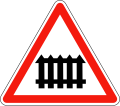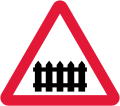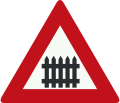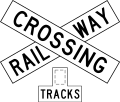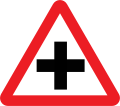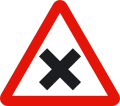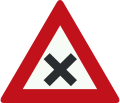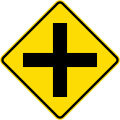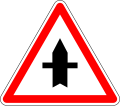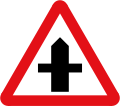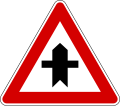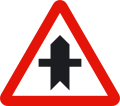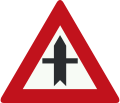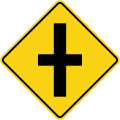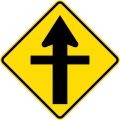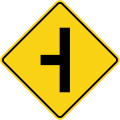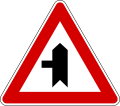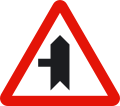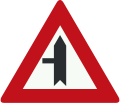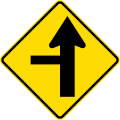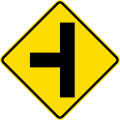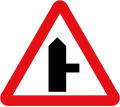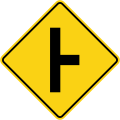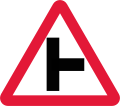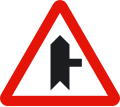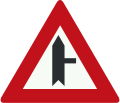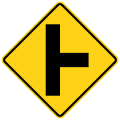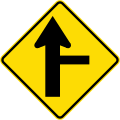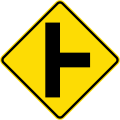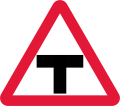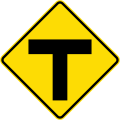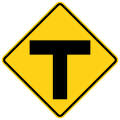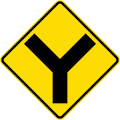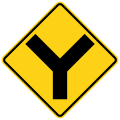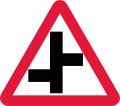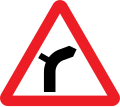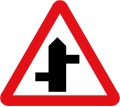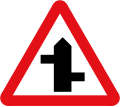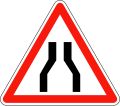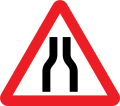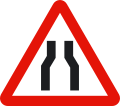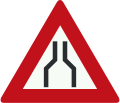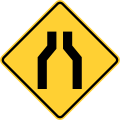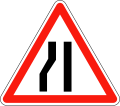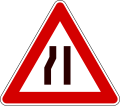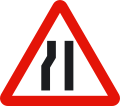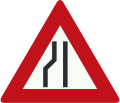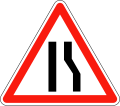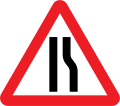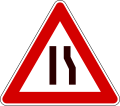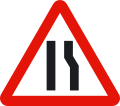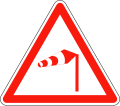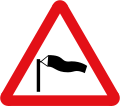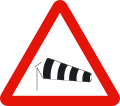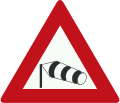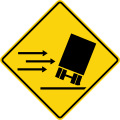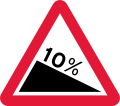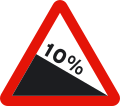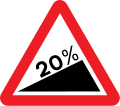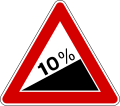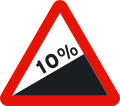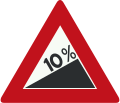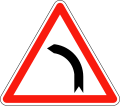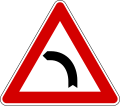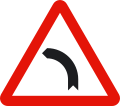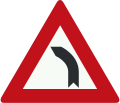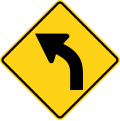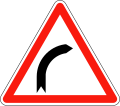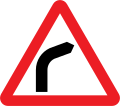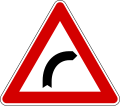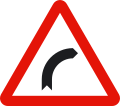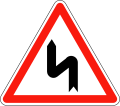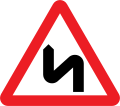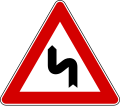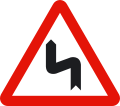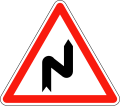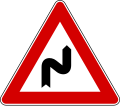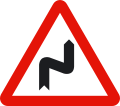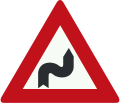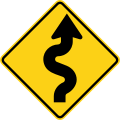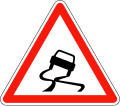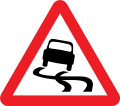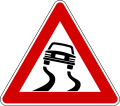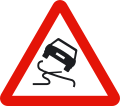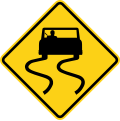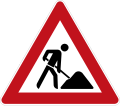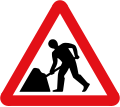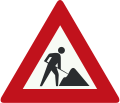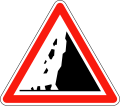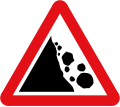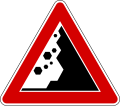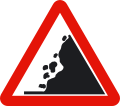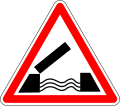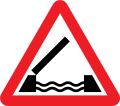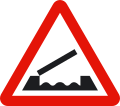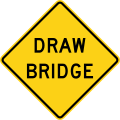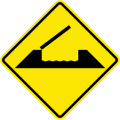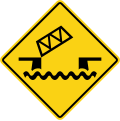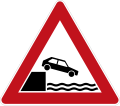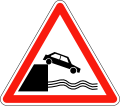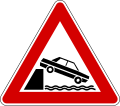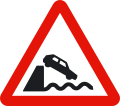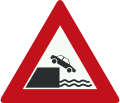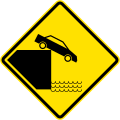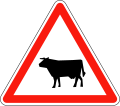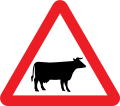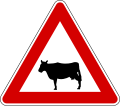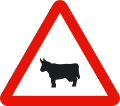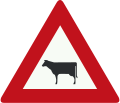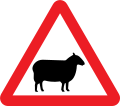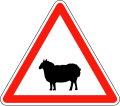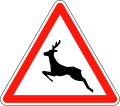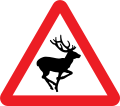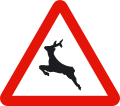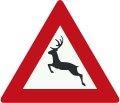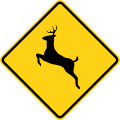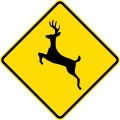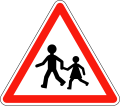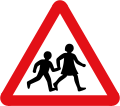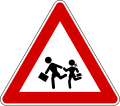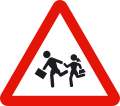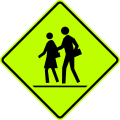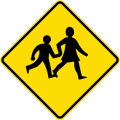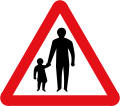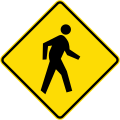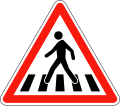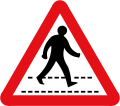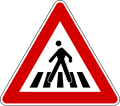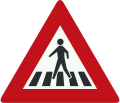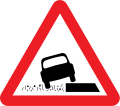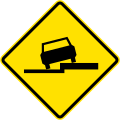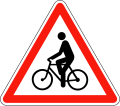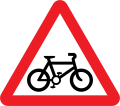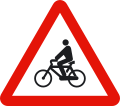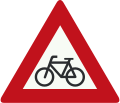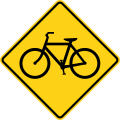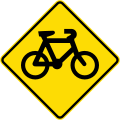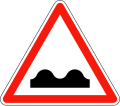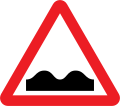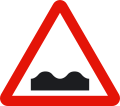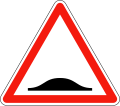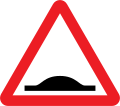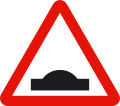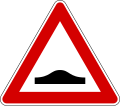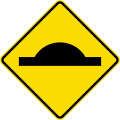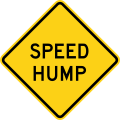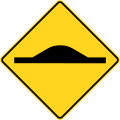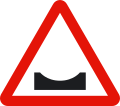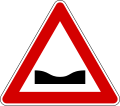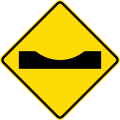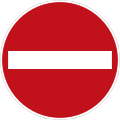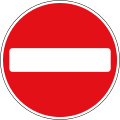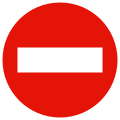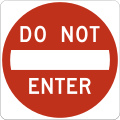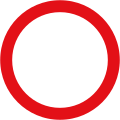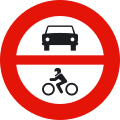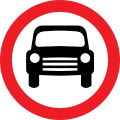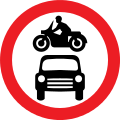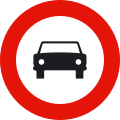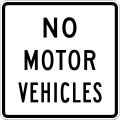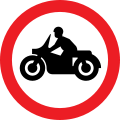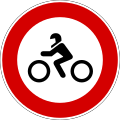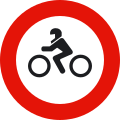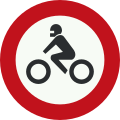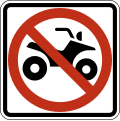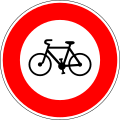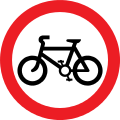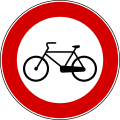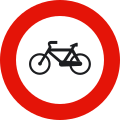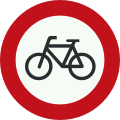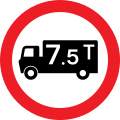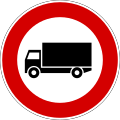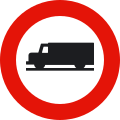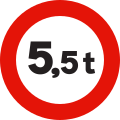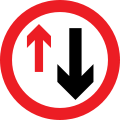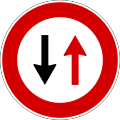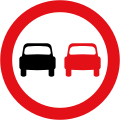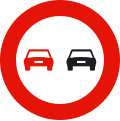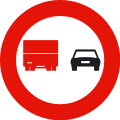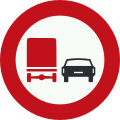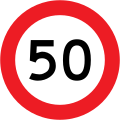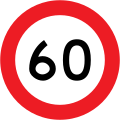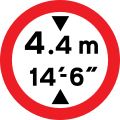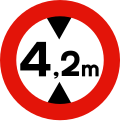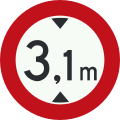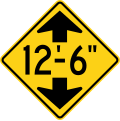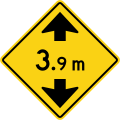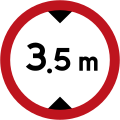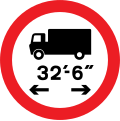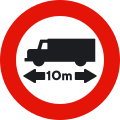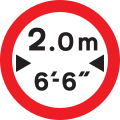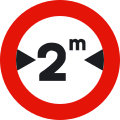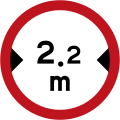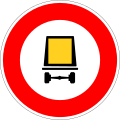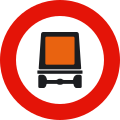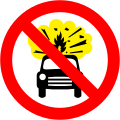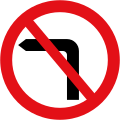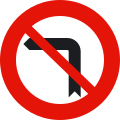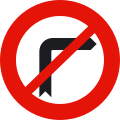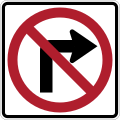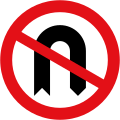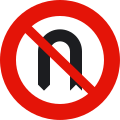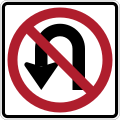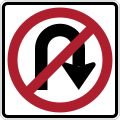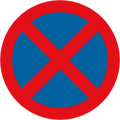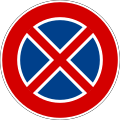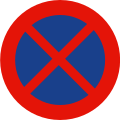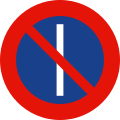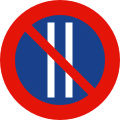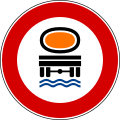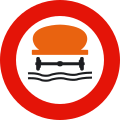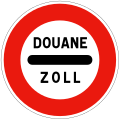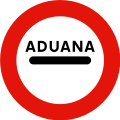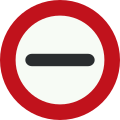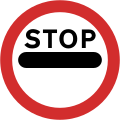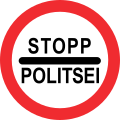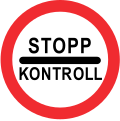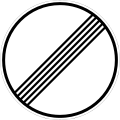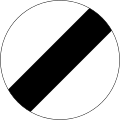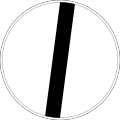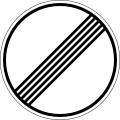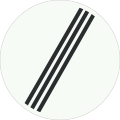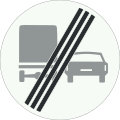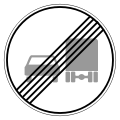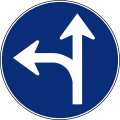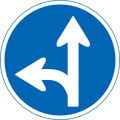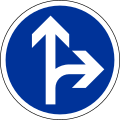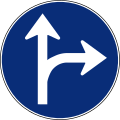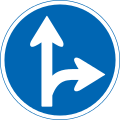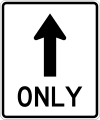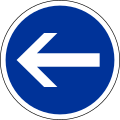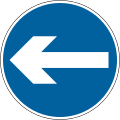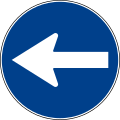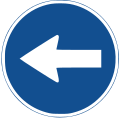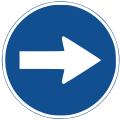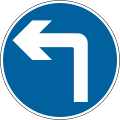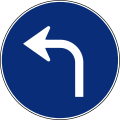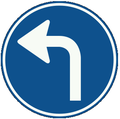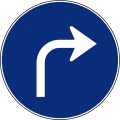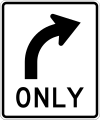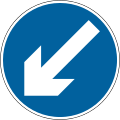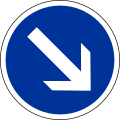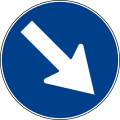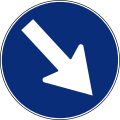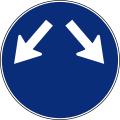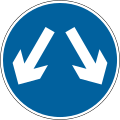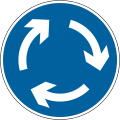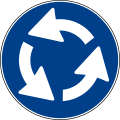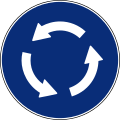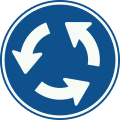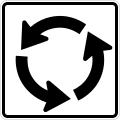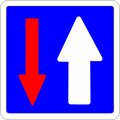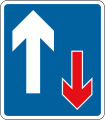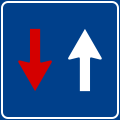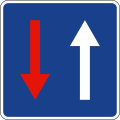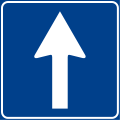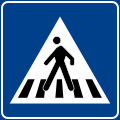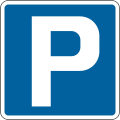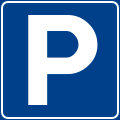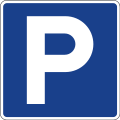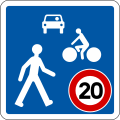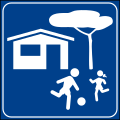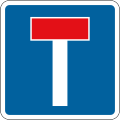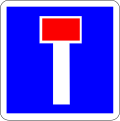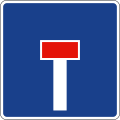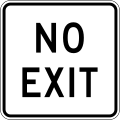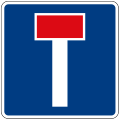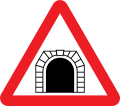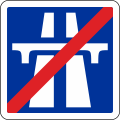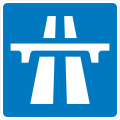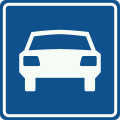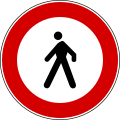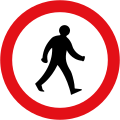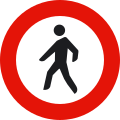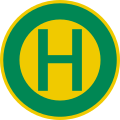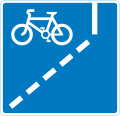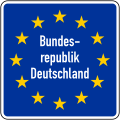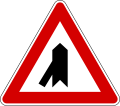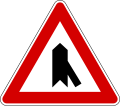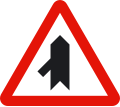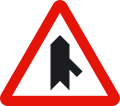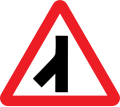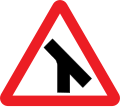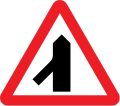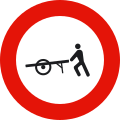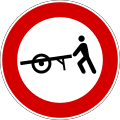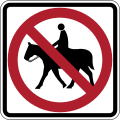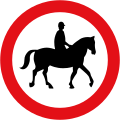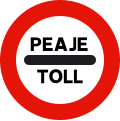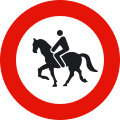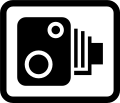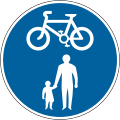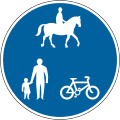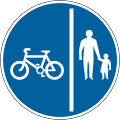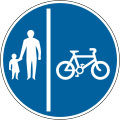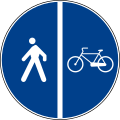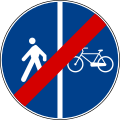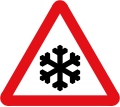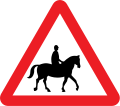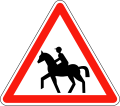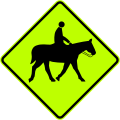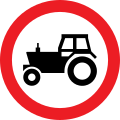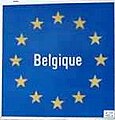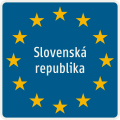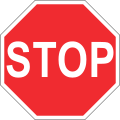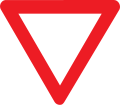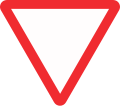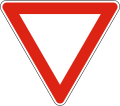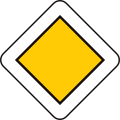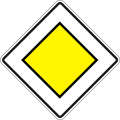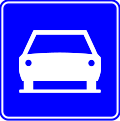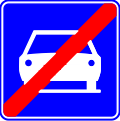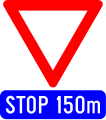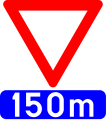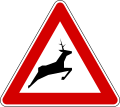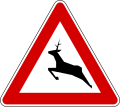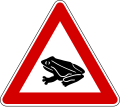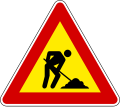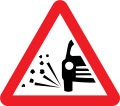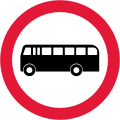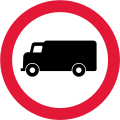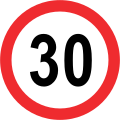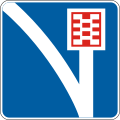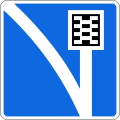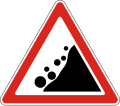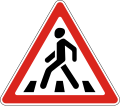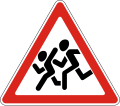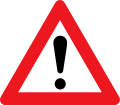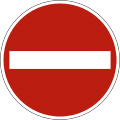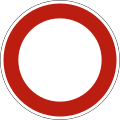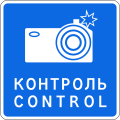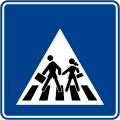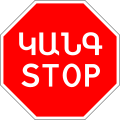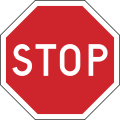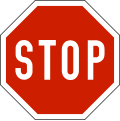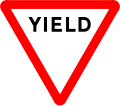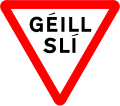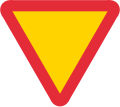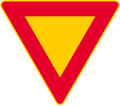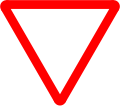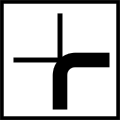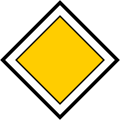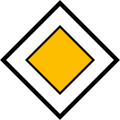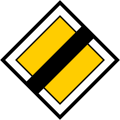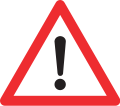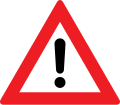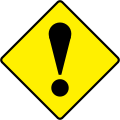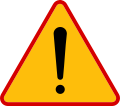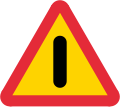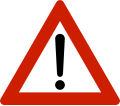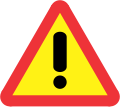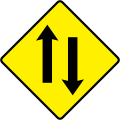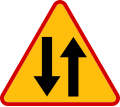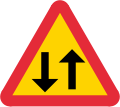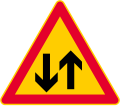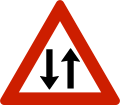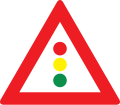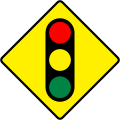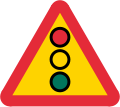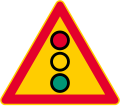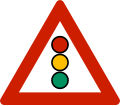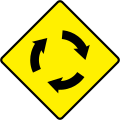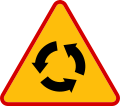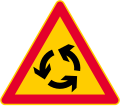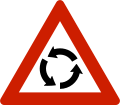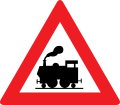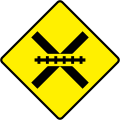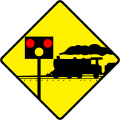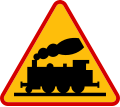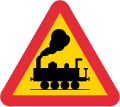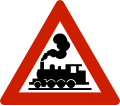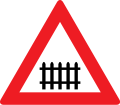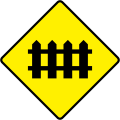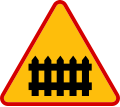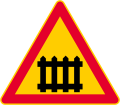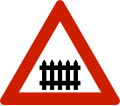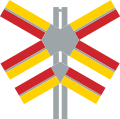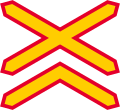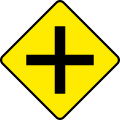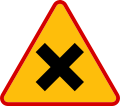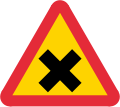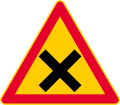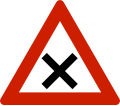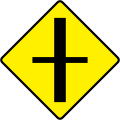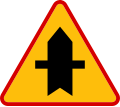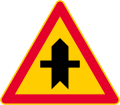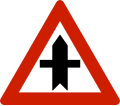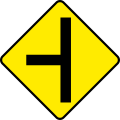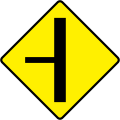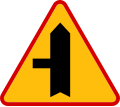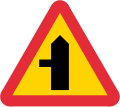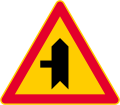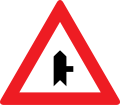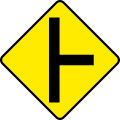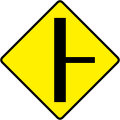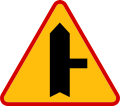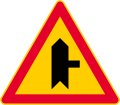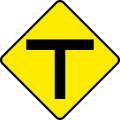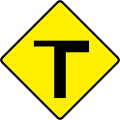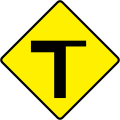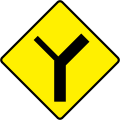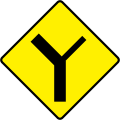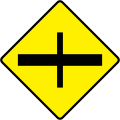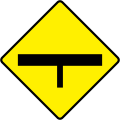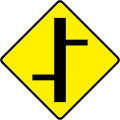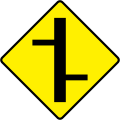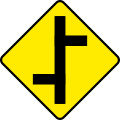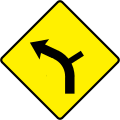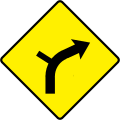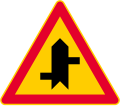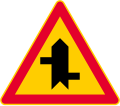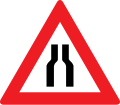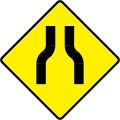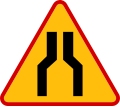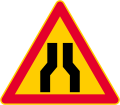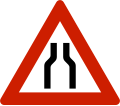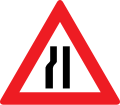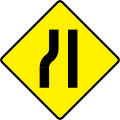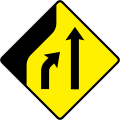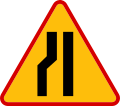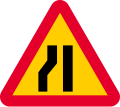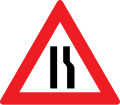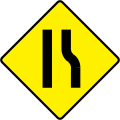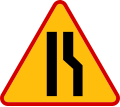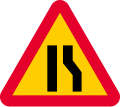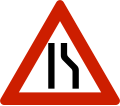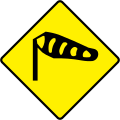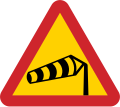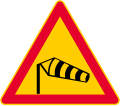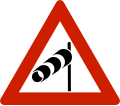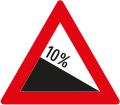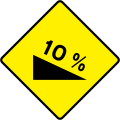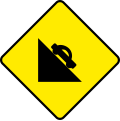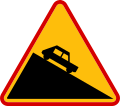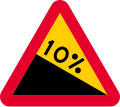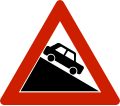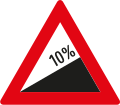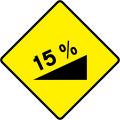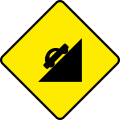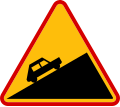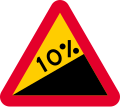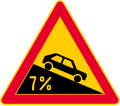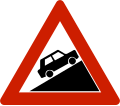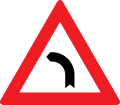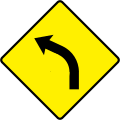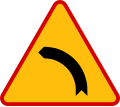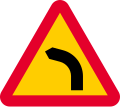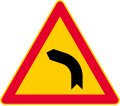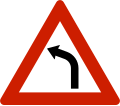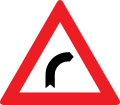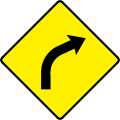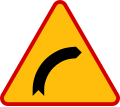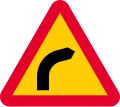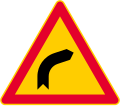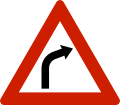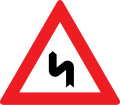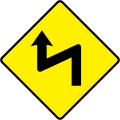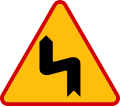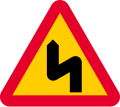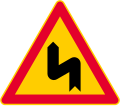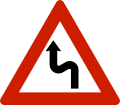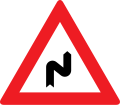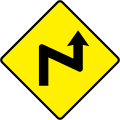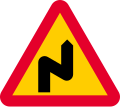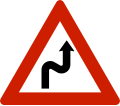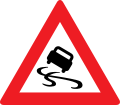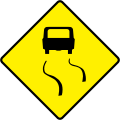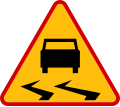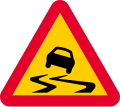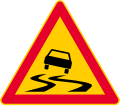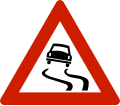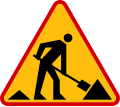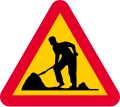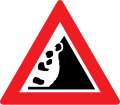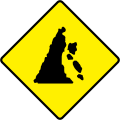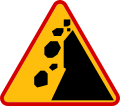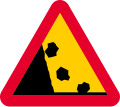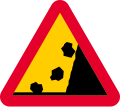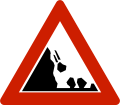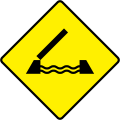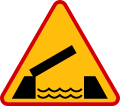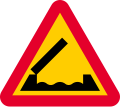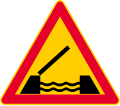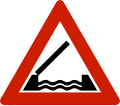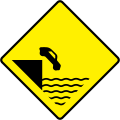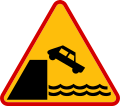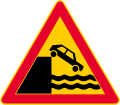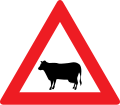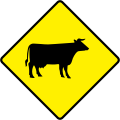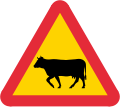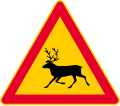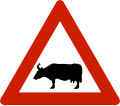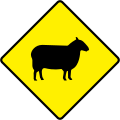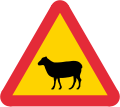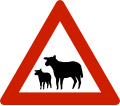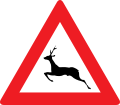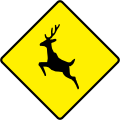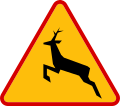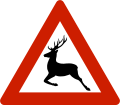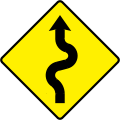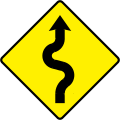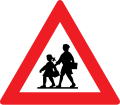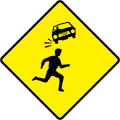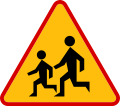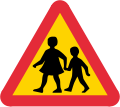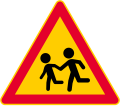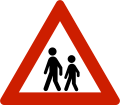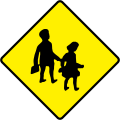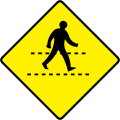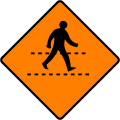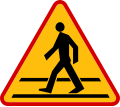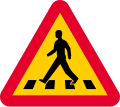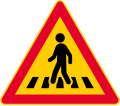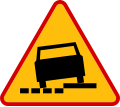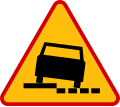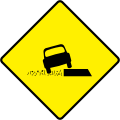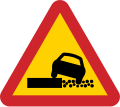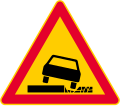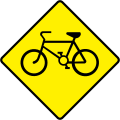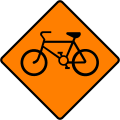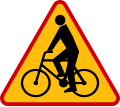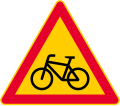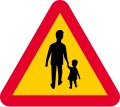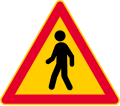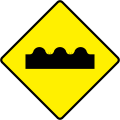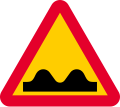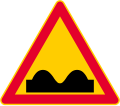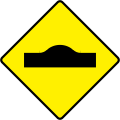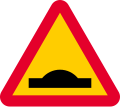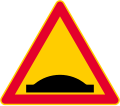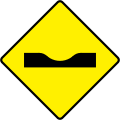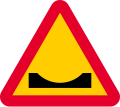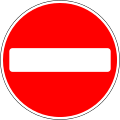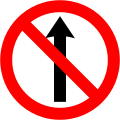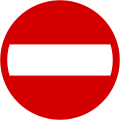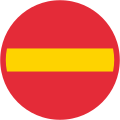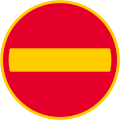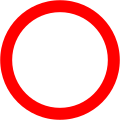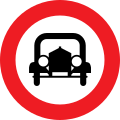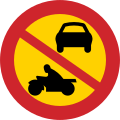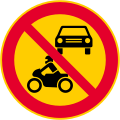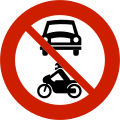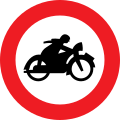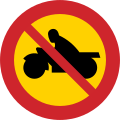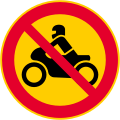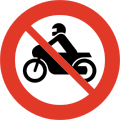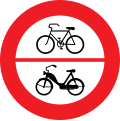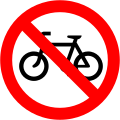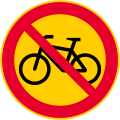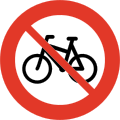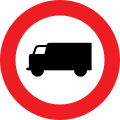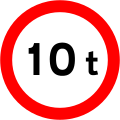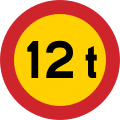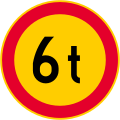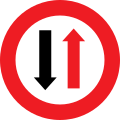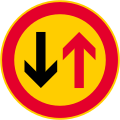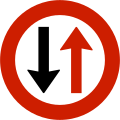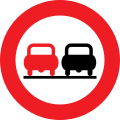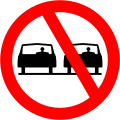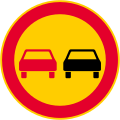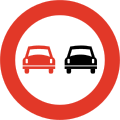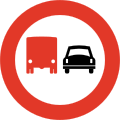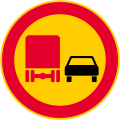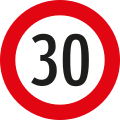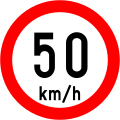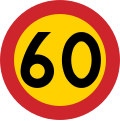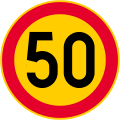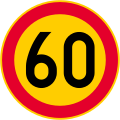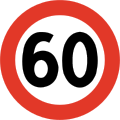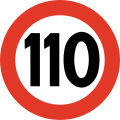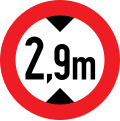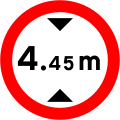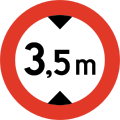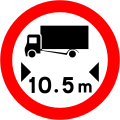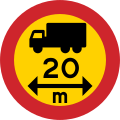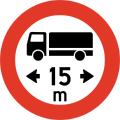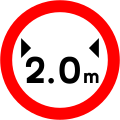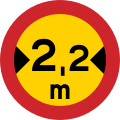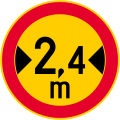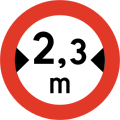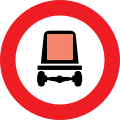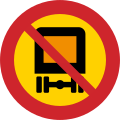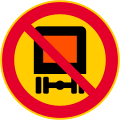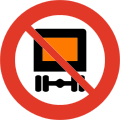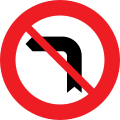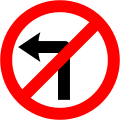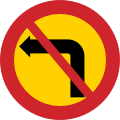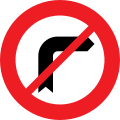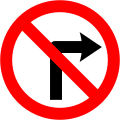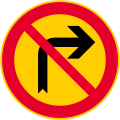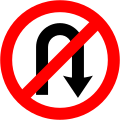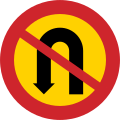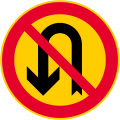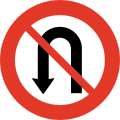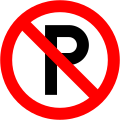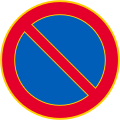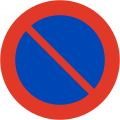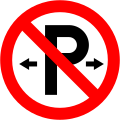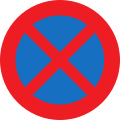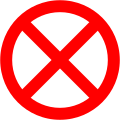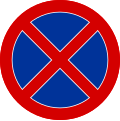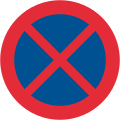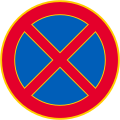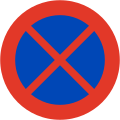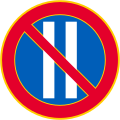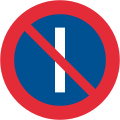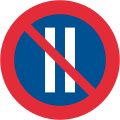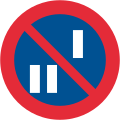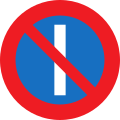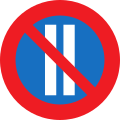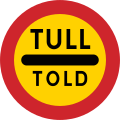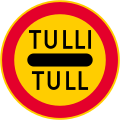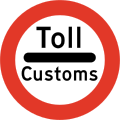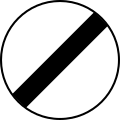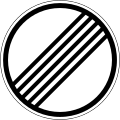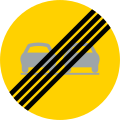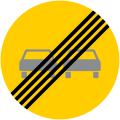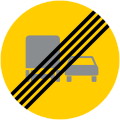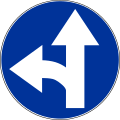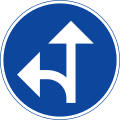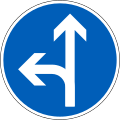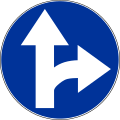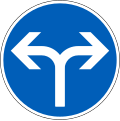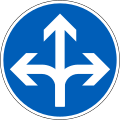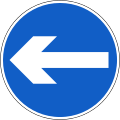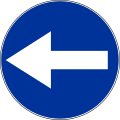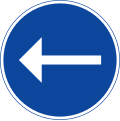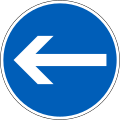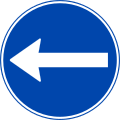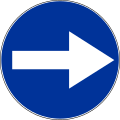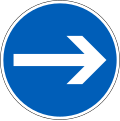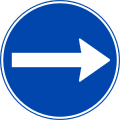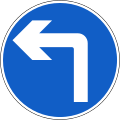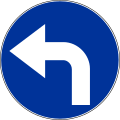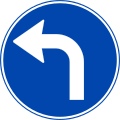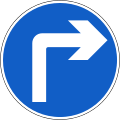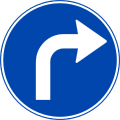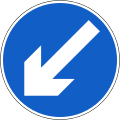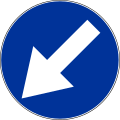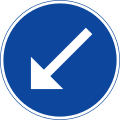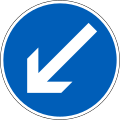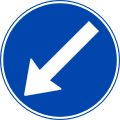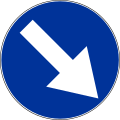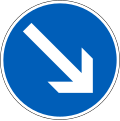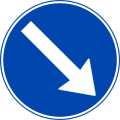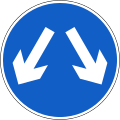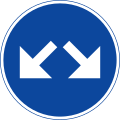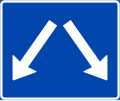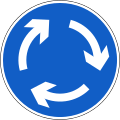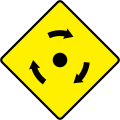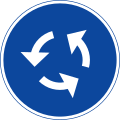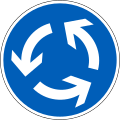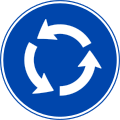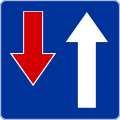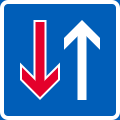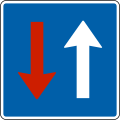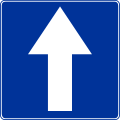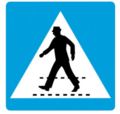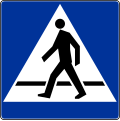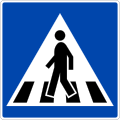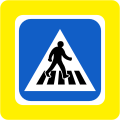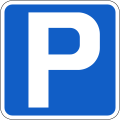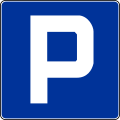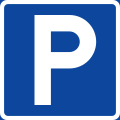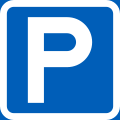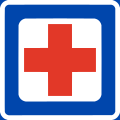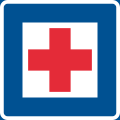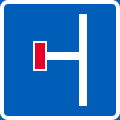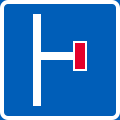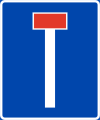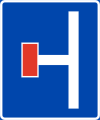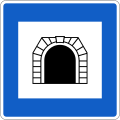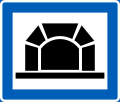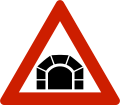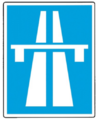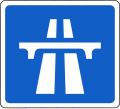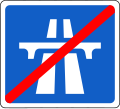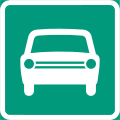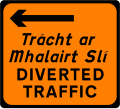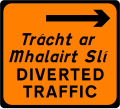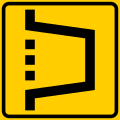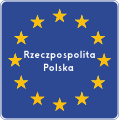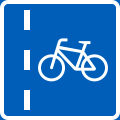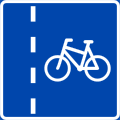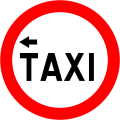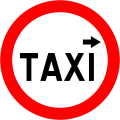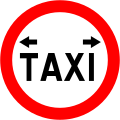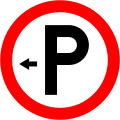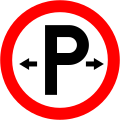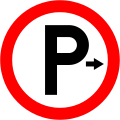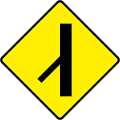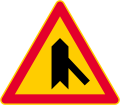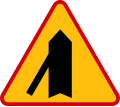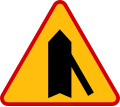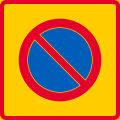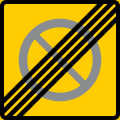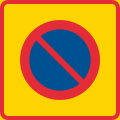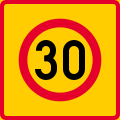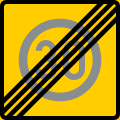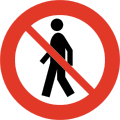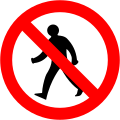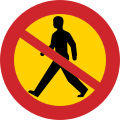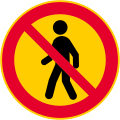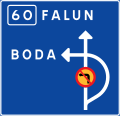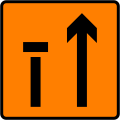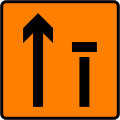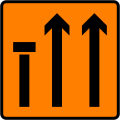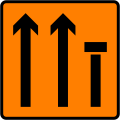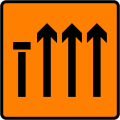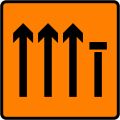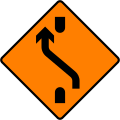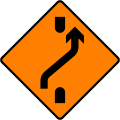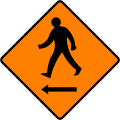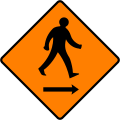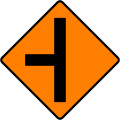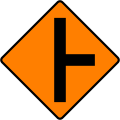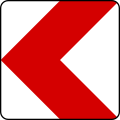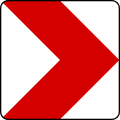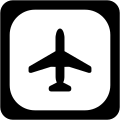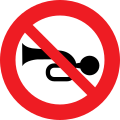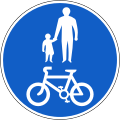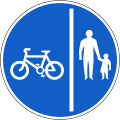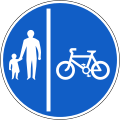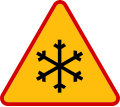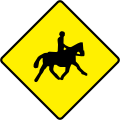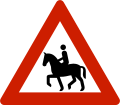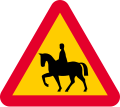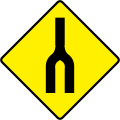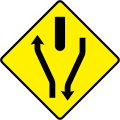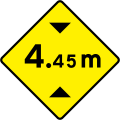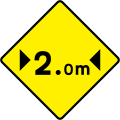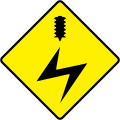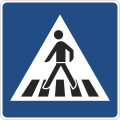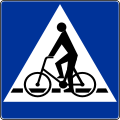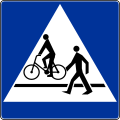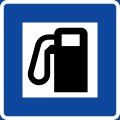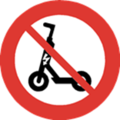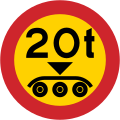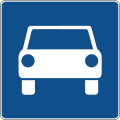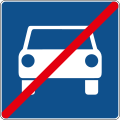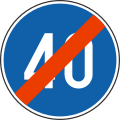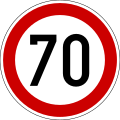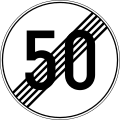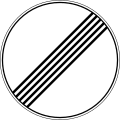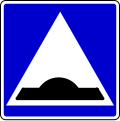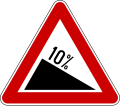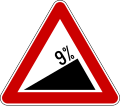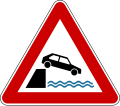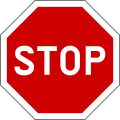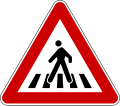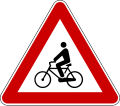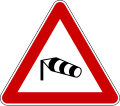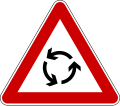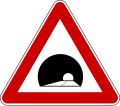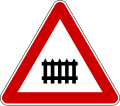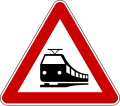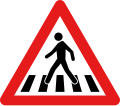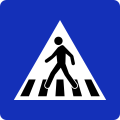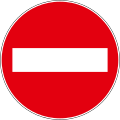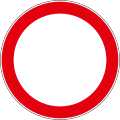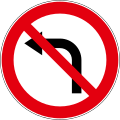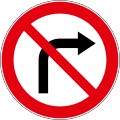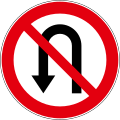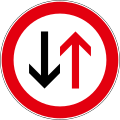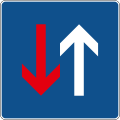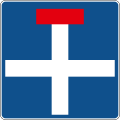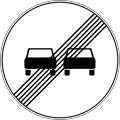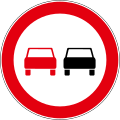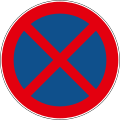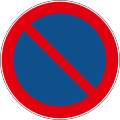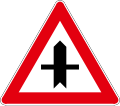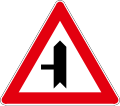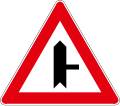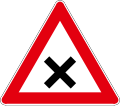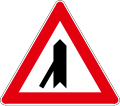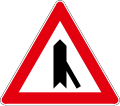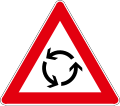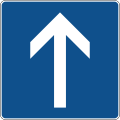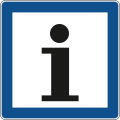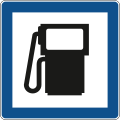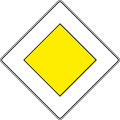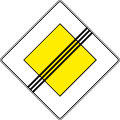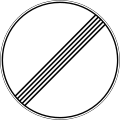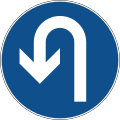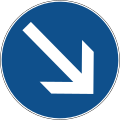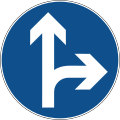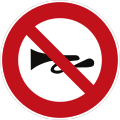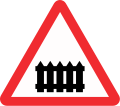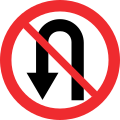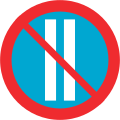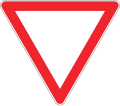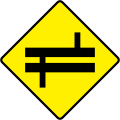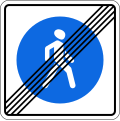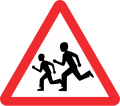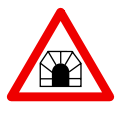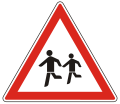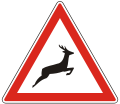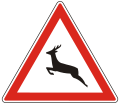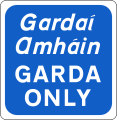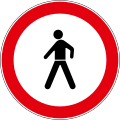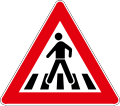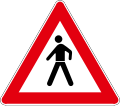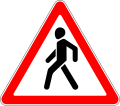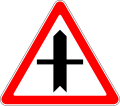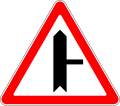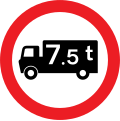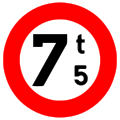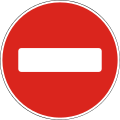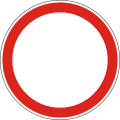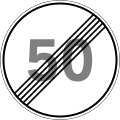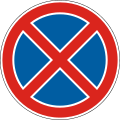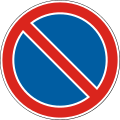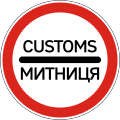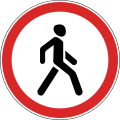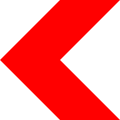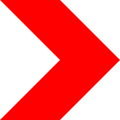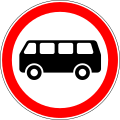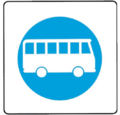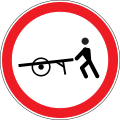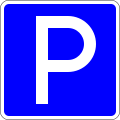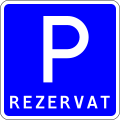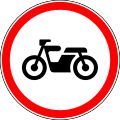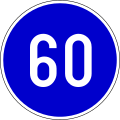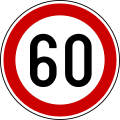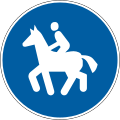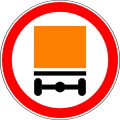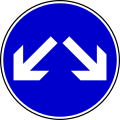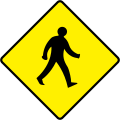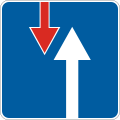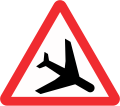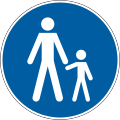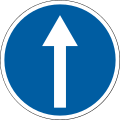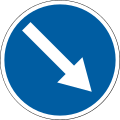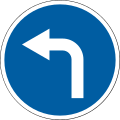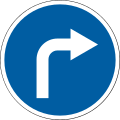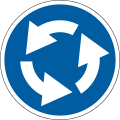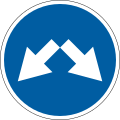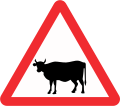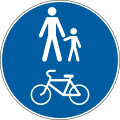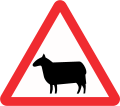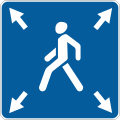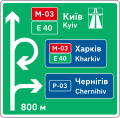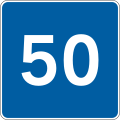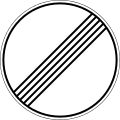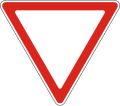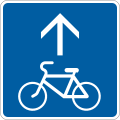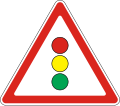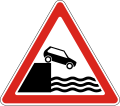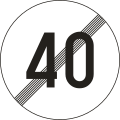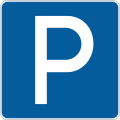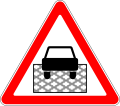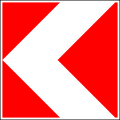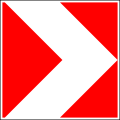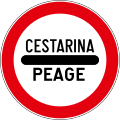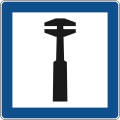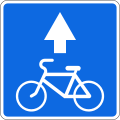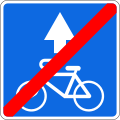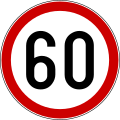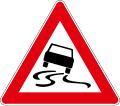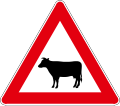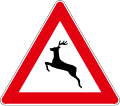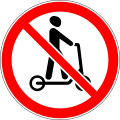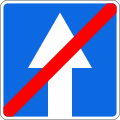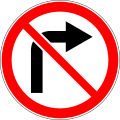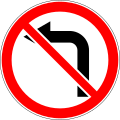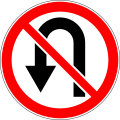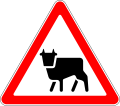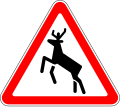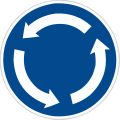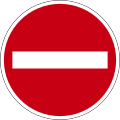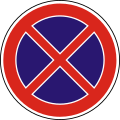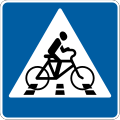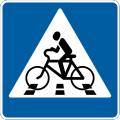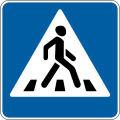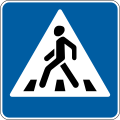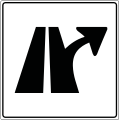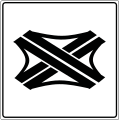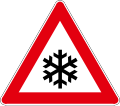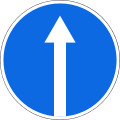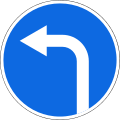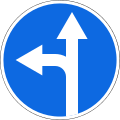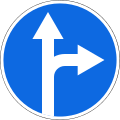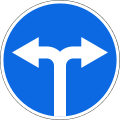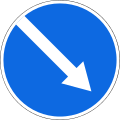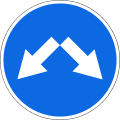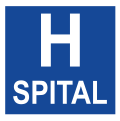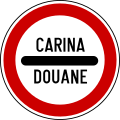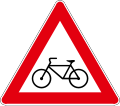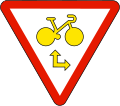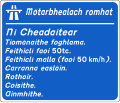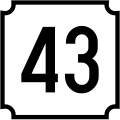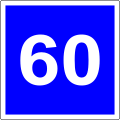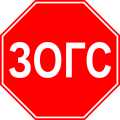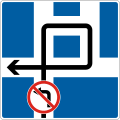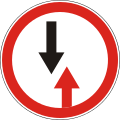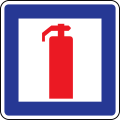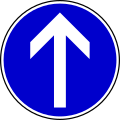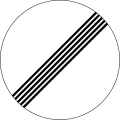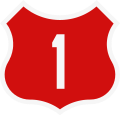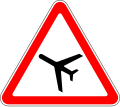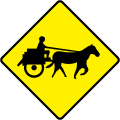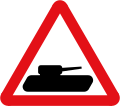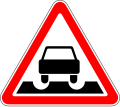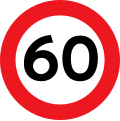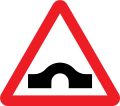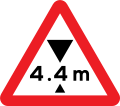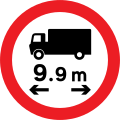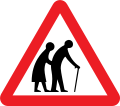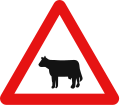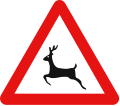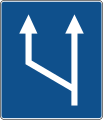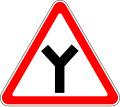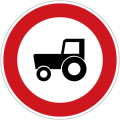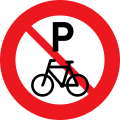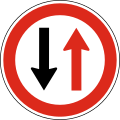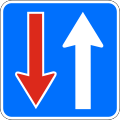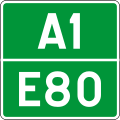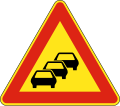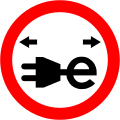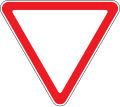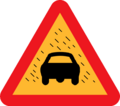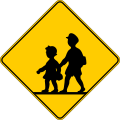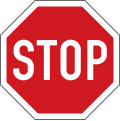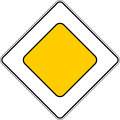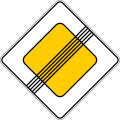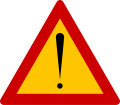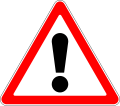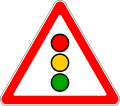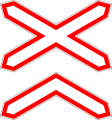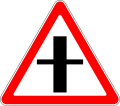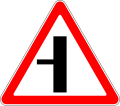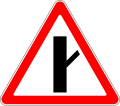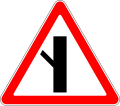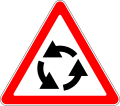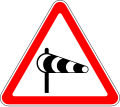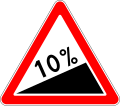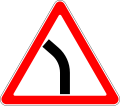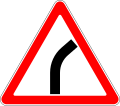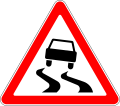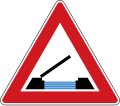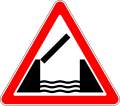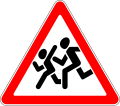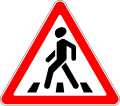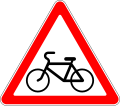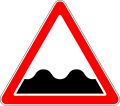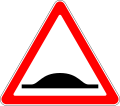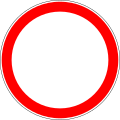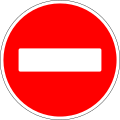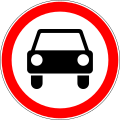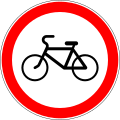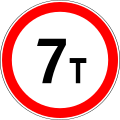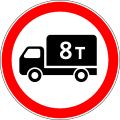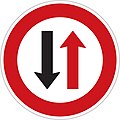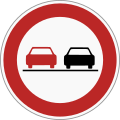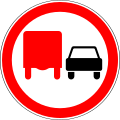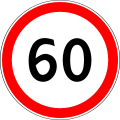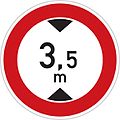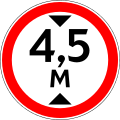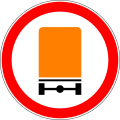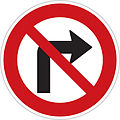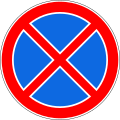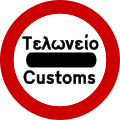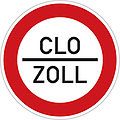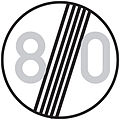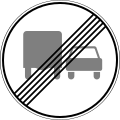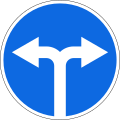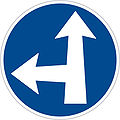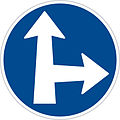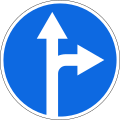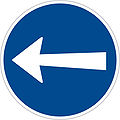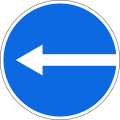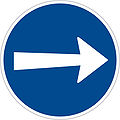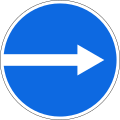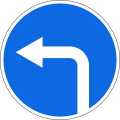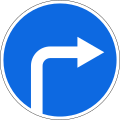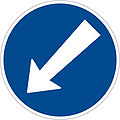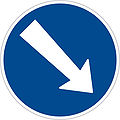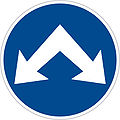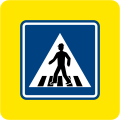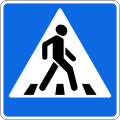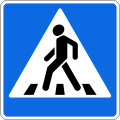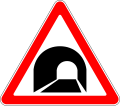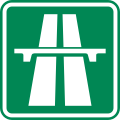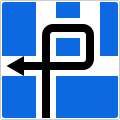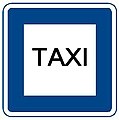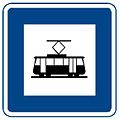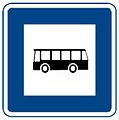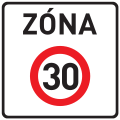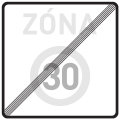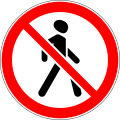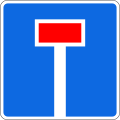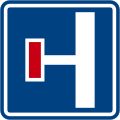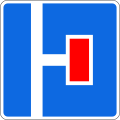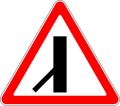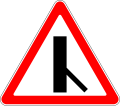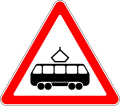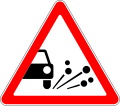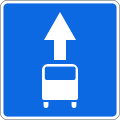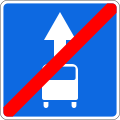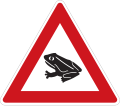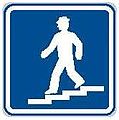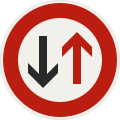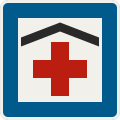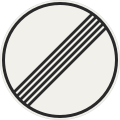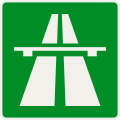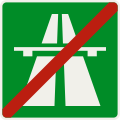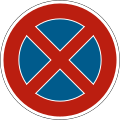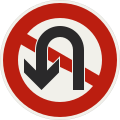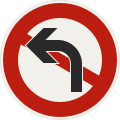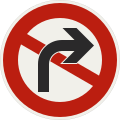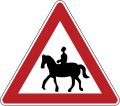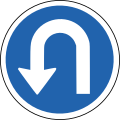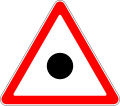
Despite an apparent uniformity and standardization, European traffic signs presents relevant differences between countries. However most European countries refer to the 1968 Vienna Convention on Road Signs and Signals — adopted in Europe by Albania, Andorra, Armenia, Austria, Belarus, Belgium, Bosnia and Herzegovina, Bulgaria, Croatia, Czech Republic, Denmark, Estonia, Finland, France, Germany, Georgia, Greece, Hungary, Italy, Latvia, Lithuania, Luxembourg, North Macedonia, Montenegro, Norway, Poland, Romania, Russia, San Marino, Serbia, Slovakia, Spain, Sweden, Switzerland, Turkey, Ukraine and the United Kingdom.
(To view this article correctly, make sure you have a high screen resolution. Otherwise, zoom out your web browser).
Differences between European traffic signs
editMain differences are related to
- graphic differences
- differences in meanings
- the use of a different colour-code scheme
- local language texts (sometimes bilingual)


Graphic differences
edit- Warning signs in the Republic of Ireland have a diamond shape with a yellow background in place of the standard triangular shape. They diverge from the standards of the rest of Europe.
- Many pictograms (tunnel, pedestrian, car, etc.) are quite different in many countries.
- Type of arrows may be different.
- Fonts of written words
Different typefaces in texts
editThese are incomplete. You can help by adding missing countries or fonts.
- France uses the Caractères font.
- Czech Republic, Germany, Greece, Kosovo, Latvia and Romania use the DIN 1451 font.
- Poland uses the Drogowskaz font.
- Denmark uses the Dansk Vejtavleskrift font.
- Netherlands, Spain, Turkey, Turkmenistan and Ukraine use the FHWA font.
- Switzerland uses the Frutiger font.
- Norway uses the Trafikkalfabetet font.
- Armenia, Bosnia-Herzegovina, Greece, Iceland, Ireland, Italy, Portugal, Turkey and the United Kingdom use the Transport font.
- Sweden uses the Tratex font.
- Slovakia uses the Universal Grotesk font.
- Estonia, Mongolia and Slovenia use the Arial Narrow Bold in mixture with Helvetica font.
- Austria and Slovakia use the TERN typeface.
- Belgium, Bosnia and Herzegovina, Bulgaria, Croatia, Luxembourg, Montenegro, North Macedonia, Romania, Slovenia, and Serbia use the SNV typeface. Switzerland used this typeface until 2003.
- Armenia, Azerbaijan, Belarus, Georgia, Lithuania, Moldova, Russia and Ukraine use typefaces based on one specified in a Soviet standard ГОСТ 10807–78 (in Russia since 1 January 2006).[1][2] In Belarus, the according standard is СТБ 1140–2013.[3] In Ukraine, it is ДСТУ 4100–2014. In Russia, it is ГОСТ Р 52290–2004.[4]
- Luxembourg uses Arial (Bold), Caractères Italic, DIN 1451, and the SNV typefaces, often inconsistently.
- Ukraine uses the Road UA typeface, as part of a signage redesign.[5]
- Hungary does not use a defined typeface as the letters are defined one-by-one in the national regulation. The typeface resembles the DIN 1451 typeface closely.[6]
Different colour codes
editWarning signs
edit- In most European countries, it is indicated by red borders and a white background.
- An amber background is used in Sweden, Serbia, Bosnia and Herzegovina, Croatia, Greece, Finland, Iceland, North Macedonia and Poland (in some other countries it means a provisional road work sign).
- Also, the yield sign in Sweden, Serbia, Croatia, Finland, Greece and Poland has a yellow background.
Road works and construction
edit- Many countries normally have adopted an amber background.
- A yellow background is used in France, Italy, Sweden, Estonia, Finland, Croatia, Iceland, Poland, Russia, Slovakia and Romania.
Motorways
edit- White texts on a blue background is used in United Kingdom, Germany, France, Spain, Netherlands, Belgium, Ireland, Austria, Luxembourg, Poland, Portugal, Latvia and Hungary.
- White texts on a green background is used in Italy, Switzerland, Denmark, Sweden, Finland, Slovenia, Croatia, Czech Republic, Greece, Cyprus, Romania, Slovakia, and Serbia.
Primary roads/Expressways
edit- White-on-blue (in this case the same as motorways for most countries, not all) is used in Belgium, Italy, Switzerland, Sweden, Czech Republic, Greece, Cyprus, Slovakia, Romania, Latvia, Finland and Netherlands.
- White-on-green is used in France, Hungary, United Kingdom, Republic of Ireland, Poland, Portugal and Slovakia .
- Black-on-yellow is used in Germany, Luxembourg, Norway, Slovenia, Serbia and Croatia.
- Red-on-white is used in Denmark (though white-on-blue on motorway exits and all overhead gantries)
- Black-on-white is used in Austria and Spain.
Secondary roads
edit- Black-on-white is used in France, United Kingdom, Finland, Ireland, Switzerland and Portugal
- In Germany, Hungary, Italy, Romania, Slovenia and Sweden, black-on-white indicates only urban roads or urban destinations.
Differences in meanings
edit- Sometimes similar signs have little differences in meanings, following the local traffic codes.[citation needed]
- European countries use the metric system (distances in kilometres or metres, speeds in kilometres per hour, heights/widths in metres) with the exception of the United Kingdom, where distances, speeds (miles per hour), heights/widths are still indicated in imperial measurements (miles, yards, feet, and inches).
Table of traffic signs comparison
editGermany, France, UK, Italy, Spain, Netherlands, Belgium
editComparison of traffic signs in seven countries of Europe (Germany, France, United Kingdom, Italy, Spain, Netherlands and Belgium).
-
Stop/Halt
-
Arrêt/Stop
-
Stop and give way
-
Fermarsi e dare precedenza/Stop
-
Detención obligatoria/Stop
-
Stop
-
Stop
-
Stop and yield
-
Vorfahrt gewähren
-
Cedez le passage
-
Give way to traffic on major road
-
Dare precedenza
-
Ceda el paso
-
Voorrang van kruispunt
-
Yield
-
Give way
-
Panneau d'arrêt devant
-
Pare adelante
-
Stop ahead
-
Stop ahead
-
Cédez le chemin à l'avance
-
Ceda adelante
-
Yield ahead
-
Give way ahead
-
Vorfahrtstraße
-
Indication de caractère prioritaire
-
Priority road
-
Diritto di precedenza
-
Calzada con prioridad
-
Voorrangsweg
-
No Sign
-
Main road
-
Ende der Vorfahrtstraße
-
Fin de caractère prioritaire
-
End of priority road
-
Fine del diritto di precedenza
-
Fin de prioridad
-
Einde voorrangsweg
-
No Sign
-
End of main road
-
Gefahrstelle
-
Panneau temporaire de signalisation de danger
-
Other danger
-
Altri pericoli
-
Otros peligros
-
Gevaar
-
No Sign
-
Other hazard
-
Gegenverkehr
-
Circulation dans les deux sens
-
Two-way traffic ahead
-
Two-way traffic crossing
-
Doppio senso di circolazione
-
Circulación en los dos sentidos
-
Inrijden toegestaan
-
Two-way traffic
-
Two-way ahead
-
Stau
-
Bouchon
-
Queues likely
-
Coda
-
Congestión
-
File
-
Queue ahead
-
Traffic queue
-
Lichtzeichenanlage
-
Feux tricolores
-
Traffic signals ahead
-
Semaforo
-
Semáforos
-
Verkeerslichten
-
Signal ahead
-
Signal ahead
-
Kreisverkehr
-
Giratoire/Rond-point devant
-
Roundabout
-
Circolazione rotatoria
-
Calzada con prioridad
-
Voorrangsweg
-
Traffic circle
-
Roundabout
-
Bahnübergang ohne Schranken
-
Passage à niveau sans barrière
-
Level crossing without barriers ahead
-
Passaggio a livello senza barriere
-
Paso a nivel sin barreras
-
Overweg zonder slagbomen
-
RR
-
Level crossing with no gates
-
Bahnübergang mit Schranken [nb 1]
-
Passage à niveau muni de barrières
-
Level crossing with barriers ahead
-
Passaggio a livello con barriere
-
Paso a nivel con barreras
-
Overweg met slagbomen
-
RR
-
Level crossing with gates
-
Position des passages à niveau
-
Position des passages à niveau à multiple voies
-
Croce di Sant'Andrea
-
Doppia croce di Sant'Andrea
-
Andreaskreuz (stehend)
-
Andreaskreuz (liegend)
-
Andreaskreuz (stehend) mit Blitzpfeil
-
Andreaskreuz mit Blitzpfeil (liegend)
-
Railway crossbuck
-
Railway crossing
-
Railway crossing with backing board
-
Railway crossing with multiple tracks
-
Railway crossing with multiple tracks (backing board)
-
Kreuzung/Intersection
-
Priorité à droite/Junction
-
Crossroads with right-of-way from the right
-
Intersezione con precedenza a destra
-
Intersección con prioridad de la derecha
-
Gevaarlijk kruispunt
-
Crossroads
-
Crossroads
-
Vorfahrt/Crossroads
-
Priorité ponctuelle/Crossroads
-
Crossroads with priority
-
Intersezione con diritto di precedenza
-
Intersección con prioridad
-
Voorrangskruispunt
-
Crossroads with priority
-
Crossroads with priority
-
Vorfahrtstraße nach links
-
Chemin de traverse à gauche
-
Side road on the left ahead
-
Side road on the left with priority
-
Intersezione con diritto di precedenza
-
Camino lateral a la izquierda
-
Zijweg links
-
Side road on the left
-
Side road on the left
-
Side road on the left
-
Vorfahrtstraße nach links
-
Chemin de traverse à droite
-
Side road on the right ahead
-
Side road on the right with priority
-
Side road on the left
-
Side road on the right
-
Intersezione con diritto di precedenza
-
Camino lateral a la derecha
-
Zijweg rechts
-
Side road on the right
-
Side road on the right
-
Side road on the right
-
T-junction
-
T-shaped intersection
-
T-junction
-
Y-shaped intersection
-
Y-junction
-
Offset side roads, left and right
-
Offset side roads, right and left
-
Junction on a bend to left
-
Junction on a bend to right
-
Junction on a curve to left
-
Junction on a curve to right
-
Staggered junction from the left
-
Staggered junction from the right
-
Curve intersection to the left
-
Curve intersection to the right
-
Verengte Fahrbahn
-
Chaussée rétrécie
-
Road narrows on both sides
-
Strettoria simmetrica
-
Estrechamiento de calzada
-
Rijbaanversmalling
-
Road narrows
-
Road narrows, two to one
-
Road narrows
-
Einseitig (rechts) verengte Fahrbahn
-
Chaussée rétrécie par la gauche
-
Road narrows on left
-
Strettoia asimmetrica a sinistra
-
Estrechamiento de calzada por la izquierda
-
Rijbaanversmalling links
-
Road narrows on the left
-
Road narrows on left
-
Einseitig (links) verengte Fahrbahn
-
Chaussée rétrécie par la droite
-
Road narrows on right
-
Strettoia asimmetrica a destra
-
Estrechamiento de calzada por la derecha
-
Rijbaanversmalling rechts
-
Road narrows on the right
-
Road narrows on right
-
Seitenwind
-
Vent
-
Side winds
-
Forte vento laterale
-
Viento transversal
-
Zijwind
-
Crosswinds
-
Wind area
-
Gefälle (10%)
-
Descente dangereuse
-
Steep hill downwards (10%)
-
Discesa pericolosa
-
Bajada con fuerte pendiente
-
Steile heiling
-
Steep descent
-
Steep descent (12%)
-
Steep descent
-
Steigung (10%)
-
Montée raide
-
Steep hill upwards (20%)
-
Ripida salita
-
Subida empinada
-
Steile klim
-
Steep ascent
-
Steep ascent (12%)
-
Kurve (links)
-
Virage à droite
-
Left bend
-
Curva a sinistra
-
Curva peligrosa hacia la izquierda
-
Bocht naar links
-
Curve to the left
-
Left curve
-
Kurve (rechts)
-
Virage à droite
-
Right bend
-
Curva a destra
-
Curva peligrosa hacia la derecha
-
Bocht naar rechts
-
Curve to the right
-
Right curve
-
Doppelkurve von links
-
Succession de virages
-
Double bend, first to left
-
Doppia curva, la prima a sinistra
-
Curvas peligrosas hacia la izquierda
-
Bochten, eerst naar links
-
Winding road (left)
-
Double curve to the left
-
Doppelkurve von rechts
-
Succession de virages
-
Double bend, first to right
-
Doppia curva, la prima a destra
-
Curvas peligrosas hacia la derecha
-
Bochten, eerst naar rechts
-
Winding road (right)
-
Double curve to the right
-
Schleudergefahr
-
Chaussée glissante
-
Slippery road
-
Strada sdrucciolevole
-
Pavimento deslizante
-
Slipgevaar
-
Slippery when wet
-
Slippery surface
-
Baustelle
-
Travaux/Road work
-
Roadworks
-
Lavori
-
Obras
-
Wegwerkzaamheden
-
Road work
-
Road work
-
Roadworks
-
Steinschlag
-
Risque de chutes de pierres
-
Falling or fallen rocks
-
Caduta massi
-
Desprendimiento
-
Vallende stenen
-
Falling rocks
-
Rock slide zone
-
Bewegliche Brücke
-
Pont mobile
-
Opening or swing bridge ahead
-
Ponte mobile
-
Puente móvil
-
Beweegbare brug
-
Draw bridge
-
Drawbridge
-
Moving bridge
-
Ufer
-
Débouché sur un quai ou une berge
-
Quayside or river bank
-
Sbocco su molo o su argine
-
Muelle
-
Kade
-
No Sign
-
Unprotected riverbank
-
Cows/Kühe
-
Cows/Vaches
-
Cows on road
-
Mucche sulla strada
-
Cows/Vacas
-
Koeien op de weg
-
Cattle
-
Watch out for cows
-
Sheep on road
-
Watch out for sheep
-
Sheep
-
Sheep/Mouton
-
Deer/Wildwechsel
-
Deer/Cerf
-
Deer on road
-
Cervo su strada
-
Deer/Ciervos
-
Groot wild
-
Deer
-
Watch out for deer
-
Kurve/Curve
-
Series of curves first to the left
-
Series of curves first to the right
-
Kinder
-
Enfants
-
Children
-
Bambini
-
Niños
-
Kinderen
-
Children
-
Children
-
Fußgänger
-
Voetgangers
-
Pedestrians
-
Pedestrians
-
Pedestrian crossing ahead
-
Fußgängerüberweg
-
Passage piéton
-
Pedestrian/Zebra crossing
-
Attraversamento pedonale
-
Situación de un paso para peatones
-
Zebrapad
-
Pedestrian crossing
-
Crosswalk
-
Weicher Rand
-
Borde suave
-
Borde suave (temporal)
-
Soft verge
-
Soft verge
-
Radverkehr
-
Espace cycliste
-
Cyclists (left)
-
Cyclists (right)
-
Attraversamento ciclabile
-
Zona ciclista
-
Fietsers en bromfietsers
-
Cyclists
-
Bicycle area
-
Unebene Fahrbahn/Unebenheiten voraus
-
Une surface irrégulière/Des bosses en avant
-
Uneven surface or road bumps
-
Perfil irregular/Golpes adelante
-
Strada dissestata/Cunetta o dosso
-
Bumps ahead
-
Humps/Bosses devant
-
Humps
-
Jorobas en el camino por adelante
-
Dosso
-
Hump
-
Speed hump
-
Road hump
-
Sumergirse en la carretera
-
Cunetta
-
Hidden dip/Ford ahead
-
Verbot der Einfahrt
-
Interdit
-
No entry for vehicular traffic
-
Senso vietato/No entry
-
Entrada prohibida
-
Gesloten in deze richting
-
Do not enter
-
No entry
-
Verbot für Fahrzeuge aller Art
-
Accès interdit/Route fermée
-
Road closed
-
Carretera cerrada a vehículos
-
Gesloten in beide richtingen voor voertuigen
-
Road closed
-
Keine Einfahrt für Autos
-
Accès interdit à tous les véhicules à moteur
-
No motor vehicles except solo motor cycles
-
No motor vehicles
-
Transito vietato a tutti gli autoveicoli
-
Entrada prohibida a vehículos de motor, excepto motocicletas de dos ruedas
-
Gesloten voor alle motorvoertuigen
-
No motor vehicles
-
Cars prohibited
-
Verbot für Krafträder, auch mit Beiwagen, Kleinkrafträder und Mofas
-
Accès interdit aux motocyclettes et motocyclettes légères
-
No motorcycles
-
Transito vietato ai motoveicoli
-
Entrada prohibida a motocicletas
-
Gesloten voor motorfietsen
-
No ATVs
-
Motorcycles prohibited
-
Motorcycles prohibited
-
Verbot für Radfahrer
-
Accès interdit aux cycles
-
No cycling
-
Transito vietato alle biciclette
-
Entrada prohibida a bicicletas
-
Gesloten voor fietsen
-
No pedal cycles
-
Cycles prohibited
-
Verbot für LKW
-
Accès interdit aux véhicules affectés au transport de marchandises
-
No heavy goods vehicles exceeding 7.5 tons
-
Transito vietato ai veicoli di massa a pieno carico superiore a 3,5 t
-
Sin entrada para camiones
-
Verboden voor voertuigen die een hogere aslast hebben dan 4,8 t
-
Maximum weight limit
-
Trucks prohibited
-
Verbot für Fahrzeuge über angegebene tatsächliche Masse
-
Accès interdit aux véhicules, véhicules articulés, trains doubles ou ensemble de véhicules dont le poids total autorisé en charge ou le poids total roulant autorisé excède le nombre indiqué
-
Limitación de masa
-
Divieto di transito a veicoli di massa
-
Maximum weight limit
-
Dem Gegenverkehr Vorfahrt gewähren
-
Cédez le passage à la circulation venant en sens inverse
-
Give priority to vehicles from opposite direction
-
Dare precedenza nei sensi unici alternati
-
Prioridad al sentido contrario
-
Voorrang verlenen
-
Yield to oncoming traffic
-
Yield to oncoming traffic
-
Überholverbot
-
Pas de dépassement
-
No overtaking
-
Divieto di sorpasso
-
No pasar
-
Inhalen verboden
-
Do not pass
-
No passing
-
Kein Überholen mit LKW
-
Pas de dépassement avec les camions
-
divieto di sorpasso per i veicoli di massa a pieno carico superiore a 3,5 t
-
No pasar con camiones
-
Geen passeren met vrachtwagens
-
No passing with trucks
-
50 km/h speed limit sign
-
60 km/h speed limit sign
-
70 km/h speed limit sign
-
Limite de vitesse (50 km/h)
-
Maximum speed (30 mph)
-
Limite massimo di velocità (50 km/h)
-
Velocidad máxima (60 km/h)
-
Maximumsnelheid (50 km/h)
-
Maximum speed limit (50 mph)
-
Maximum speed limit (50 km/h)
-
Maximum speed limit (80 km/h)
-
50 km/h speed limit
-
60 km/h speed limit
-
Höchsthöhe
-
Accès interdit aux véhicules dont la hauteur, chargement compris, est supérieure au nombre indiqué
-
No vehicles over height shown
-
Altezza massima
-
Prohibido el paso a vehículos superiores a la altura máxima indicada
-
Gesloten voor voertuigen die hoger zijn dan gezecht
-
Low clearance
-
Metric low clearance
-
Maximum height limit
-
Höchstlänge
-
Accès interdit aux véhicules dont la longueur est supérieure au nombre indiqué
-
No vehicles over length shown
-
Lunghezza massima
-
Limitación de longitud
-
Maximum length limit
-
Maximum length
-
Verbot für Fahrzeuge über angegebene tatsächliche Breite
-
Accès interdit aux véhicules dont la largeur, chargement compris, est supérieure au nombre indiqué
-
No vehicles over width shown
-
Larghezza massima
-
Limitación de anchura
-
Maximum width limit
-
Maximum width
-
Width limit
-
Gesloten voor voertuigen die
-
Verbot für kennzeichnungspflichtige Kraftfahrzeuge mit gefährlichen Gütern
-
Accès interdit aux véhicules transportant des marchandises dangereuses
-
Vehicles carrying dangerous goods prohibited
-
Transito vietato ai veicoli che trasportano merci pericolose
-
Entrada prohibida a vehículos que transporten mercancías peligrosas
-
Gesloten voor voertuigen die gevaarklijke stoffen vervoerd
-
No Sign
-
No vehicles carrying hazardous materials
-
Abbiegen nach links verboten
-
Pas de virage à gauche
-
No left turn
-
Nessuna svolta a sinistra
-
Giro a la izquierda prohibido
-
Geen linkse afslag
-
No left turn
-
No left turn
-
Abbiegen nach rechts verboten
-
Pas de virage à droite
-
No right turn
-
Nessuna svolta a destra
-
Giro a la derecha prohibido
-
Verboden rechtsaf te slaan
-
No right turn
-
No right turn
-
Wendeverbot
-
Interdiction de faire demi-tour sur la route suivie jusqu’à la prochaine intersection
-
No U-turns
-
Divieto di svolta ad U
-
Media vuelta prohibida
-
Keerverbod
-
No U-turn
-
No U-turn
-
No U-turns
-
No parking/Parkverbot
-
Stationnement interdit
-
No waiting
-
Divieto di sosta
-
Estacionamiento prohibido
-
Parkeerverbod
-
No parking
-
No waiting
-
Parkverbot (Ende)
-
Parkverbot (Mitte)
-
Parkverbot (Anfang)
-
No parking
-
No stopping/Haltverbot
-
Arrêt interdit
-
No stopping (clearway)
-
Divieto di fermata
-
Parada y estacionamiento prohibidos
-
Verboden stil te staan
-
No stopping
-
Stopping and parking prohibited
-
Haltverbot (Ende)
-
Haltverbot (Mitte)
-
Haltverbot (Anfang)
-
Estacionamiento prohibido los días impares
-
Estacionamiento prohibido los días pares
-
No vehicles carrying hazardous goods
-
Accès interdit aux véhicules transportant des marchandises susceptibles de polluer les eaux
-
No vehicles carrying explosives
-
Divieto di transito ai veicoli che trasportano prodotti suscettibili di contaminare l'acqua
-
Entrada prohibida a vehículos que transporten productos contaminantes del agua
-
Geen voertuigen die goederen vervoerd die het water kan vervuilen
-
No vehicles carrying hazardous goods which may pollute water
-
Zoll
-
Douane
-
Customs
-
Alt-Dogana
-
Aduana
-
Tolpost
-
No Sign
-
Passing without stopping permitted
-
Police control
-
Control/Kontroll
-
Ende sämtlicher Streckenverbote
-
Fin de toutes les interdictions précédemment signalées, imposées aux véhicules en mouvement
-
Derestriction, national speed limit applies
-
Via libera
-
Fin de restricciones impuestas
-
Einde verbod
-
No Sign
-
End of speed limit
-
End of 50 km/h speed limit sign
-
Fin de limitation de vitesse (50 km/h)
-
National speed limit applies
-
Einde maximumsnelheid
-
Ende des Nichtüberholens
-
Fin du non-passage
-
Einde verbod voor motorvoertuigen om elkaar onderling in te halen
-
End of no passing
-
Ende der Überholverbote mit LKW
-
Fin du non-passage avec les camions
-
Einde verbod voor vrachtauto's om motorvoertuigen in te halen
-
End of no passing with trucks
-
Fahren Sie geradeaus oder biegen Sie links ab
-
Allez tout droit ou tournez à gauche
-
Ga rechtdoor of sla linksaf
-
Siga recto o gire a la izquierda
-
Go straight or turn left
-
Go straight or turn left
-
Fahren Sie geradeaus oder biegen Sie rechts ab
-
Allez tout droit ou tournez à droite
-
Ga rechtdoor of sla rechtsaf
-
Siga recto o gire a la derecha
-
Go straight or turn right
-
Go straight or turn right
-
Links oder rechts abbiegen
-
Tourner à gauche ou à droite devant
-
Sla links of rechts vooruit
-
Gire a la izquierda o a la derecha adelante
-
Turn left or right
-
Nur voraus (keine Drehungen)
-
Devant seulement (pas de virages)
-
Ahead only
-
Direzione obbligatoria diritto
-
Solo por delante (sin giros)
-
Alleen vooruit (geen bochten)
-
Ahead only (no turns)
-
Ahead only (no turns)
-
No turns
-
Vorgeschriebene Fahrtrichtung - hier links
-
Tournez à gauche
-
Turn left
-
Direzione obbligatoria a sinistra
-
Girar a la izquierda
-
Sla linksaf
-
Turn left
-
Turn left
-
Vorgeschriebene Fahrtrichtung - hier rechts
-
Tournez à droite
-
Turn right
-
Direzione obbligatoria a destra
-
Girar a la derecha
-
Sla rechtsaf
-
Turn right
-
Turn right
-
Vorgeschriebene Fahrtrichtung - links
-
Tourner à gauche devant
-
Turn left ahead
-
Preavviso di direzione obbligatoria a sinistra
-
Gire a la izquierda adelante
-
Sla linksaf vooruit
-
Turn left ahead
-
Turn left ahead
-
Vorgeschriebene Fahrtrichtung - rechts
-
Tourner à droite devant
-
Turn right ahead
-
Preavviso di direzione obbligatoria a destra
-
Gire a la derecha adelante
-
Sla rechtsaf vooruit
-
Turn right ahead
-
Turn right ahead
-
Vorgeschriebene Fahrtrichtung - links vorbei
-
Contournement obligatoire par la gauche
-
Keep left
-
Passaggio obbligatorio a sinistra
-
Mantengase a la izquierda
-
Keep left
-
Links passeren
-
Pass to the left
-
Vorgeschriebene Fahrtrichtung - rechts vorbei
-
Contournement obligatoire par la droite
-
Keep right
-
Passaggio obbligatorio a destra
-
Mantengase a la derecha
-
Rechts passeren
-
Keep right
-
Pass to the right
-
Passaggi consentiti
-
Pase a cualquier lado
-
Diverge
-
Lane split
-
Diverge
-
Diverge
-
Kreisverkehr
-
Giratoire
-
Mini-roundabout (roudabout circulation: give way to vehicles from the immediate right)
-
Rotatoria
-
Rotonda
-
Rotonde
-
Roundabout
-
Traffic circle
-
Yield at roundabout
-
Vorrang vor dem Gegenverkehr
-
Priorité avec le passage à la circulation venant en sens inverse
-
Traffic has priority over oncoming vehicles
-
Diritto di precedenza nei sensi unici alternati
-
Prioridad respecto al sentido contrario
-
Voorrang verlenen van tegenmoetkomende verkeer
-
No Sign
-
To oncoming traffic
-
Priority over oncoming traffic
-
Priority over oncoming traffic/Преимущество перед встречным движением
-
Ρυθμιστική πινακίδα
-
Einbahnstraße (geradeausweisend)
-
Circulation à sens unique devant (pas de virages)
-
One-way traffic (no turns)
-
Senso unico frontale
-
Tráfico unidireccional adelante (sin giros)
-
Eenrichtingsweg
-
Begin one way
-
End one way
-
One way traffic from the left
-
One way traffic from the right
-
One-way traffic from the left
-
One-way traffic from the right
-
Fußgängerüberweg
-
Passage piéton
-
Zebra crossing
-
Attraversamento pedonale
-
Situación de un paso para peatones
-
Zebrapad
-
Pedestrian crossing
-
Crosswalk
-
Parkplatz/Parking
-
Parking
-
Parking place
-
Parcheggio/Parking
-
Estacionamiento
-
Parkeerplaats
-
Parking
-
Parking
-
Parkplatz (Ende)
-
Parkplatz (Mitte)
-
Parkplatz (Anfang)
-
Beginn eines verkehrsberuhigten Bereichs
-
Entrée d’une zone de rencontre
-
Home zone begins
-
Zona residenziale
-
Calle residencial
-
Erf
-
Neigbourhood zone
-
Shared zone
-
Sackgasse/Dead end
-
No through road
-
Sans issue
-
Sans issue
-
Calle sin salida
-
Strada senza uscita
-
No exit
-
Dead end
-
Ende eines verkehrsberuhigten Bereichs
-
Fin de calle residencial
-
Home zone ends
-
Tunnel
-
Entrée d’un tunnel
-
Tunnel ahead
-
Traforo/Tunnel
-
Túnel
-
Tunnel in 17 km
-
Tunnel
-
Tunnel
-
Autobahn
-
End of Autobahn
-
Autoroute
-
Autoroute ends
-
Motorway
-
Autostrada
-
Autopista
-
End of autopista
-
Snelweg
-
Einde snelweg
-
Freeway
-
Motorway
-
End of motorway
-
Dual carriageway
-
End of dual carriageway
-
Kraftfahrstraße
-
Route à chaussées séparées
-
Expressway
-
Strada riservata ai veicoli a motore
-
Autovía
-
Autoweg
-
Expressway ends
-
Single carriageway
-
End of single carriageway
-
Verbot für Fußgänger
-
Accès interdit aux piétons
-
Transito vietato ai pedoni
-
No pedestrians
-
Pedestrians prohibited
-
No pedestrians
-
Entrada prohibida a peatones
-
Schwierige Verkehrsführung
-
Svolta
-
Detour to the left
-
Detour to the right
-
Preseñalización de itinerario
-
Bushaltestelle
-
Bus stop
-
Arrêt de bus
-
Bus stop
-
Beginn der Fahrradstraße
-
Cycle lane
-
Contra-flow cycle lane
-
Cycle lane
-
Truck lane
-
Shared path
-
Grenzübergang
-
Poste frontière
-
Border crossing
-
Confine
-
Cruce de fronteras
-
Grensovergang
-
No Sign
-
Border crossing checkpoint
-
Left merging traffic
-
Right merging traffic
-
Confluenza a sinistra
-
Confluenza a destra
-
Con prioridad sobre incorporación por la izquierda
-
Con prioridad sobre incorporación por la derecha
-
Merge to the left
-
Merge to the right
-
Merge into left
-
Merge into right
-
Merge to the left
-
Merge to the right
-
Entrada prohibida a carros de mano
-
Transito a veicoli a braccia
-
Verbot für Reiter
-
Horse riders prohibited
-
No ridden horses
-
Voie de détresse à gauche
-
Voie de détresse à droite
-
Rampa de escape de camiones
-
Escape lane ahead
-
Mautpflicht nach dem Bundesfernstraßenmautgesetz
-
Mautpflichtige Strecke
-
Control policia
-
Peaje/Toll
-
Road charging zone
-
Accès interdit aux véhicules transportant des marchandises explosives ou facilement inflammables
-
Entrada prohibida para caballos
-
Left curve chevron
-
Right curve chevron
-
Speed camera ahead
-
20 mph speed camera area
-
End of speed camera area
-
30 km/h speed camera area
-
Signaux sonores interdits
-
Fin d’interdiction de l’usage de l’avertisseur sonore
-
Divieto di segnalazioni acustiche
-
Panneau indiquant une surélévation de chaussée
-
Blue exit ramp sign
-
White exit ramp sign
-
Interchange exit
-
Ortstafel
-
Panneau d'entrée d'agglomération
-
Panneau de sortie d'agglomération
-
Entfernungstafel
-
Kontenpunkte/Exit number 26
-
Bicycles and pedestrians only
-
Horses, bicycles and pedestrians only
-
Shared path
-
Shared path
-
Shared path, Italy
-
End of shared path, Italy
-
Getrennter Rad- und Fußweg
-
Glättegefahr/Ice
-
Black ice prone area
-
Accompanied horse riders crossing
-
Horses/Reitweg
-
Horses/Chevaux
-
Ridden horses ahead
-
Example of junction advance sign
-
No tractors
-
Traktoren verboten
-
Poste frontière
-
ГКПП
-
Piiriületuspunkt
-
Hraničný priechod
-
Stop en geef toe/Arrêtez et cédez/Stoppen und nachgeben
-
Peatu ja anna järele/Stop
-
Спри! Спрете и се отдайте/Stop and yield
-
Verleen voorrang aan bestuurders op de kruisende weg/Cédez le passage/Vorfahrt gewähren
-
Yield
-
Дайте път на целия трафик/Give way
-
Voorrangsweg/Indication de caractère prioritaire/Vorfahrtstraße
-
Peatee/Main road
-
Път с предимство/Start of main road
-
Rijstroken komen samen/Fusion de voies/Fahrspuren fusionieren
-
Snelweg/Autoroute/Autobahn
-
Einde snelweg/Fin de l'autoroute/Ende der Autobahn
-
Snelweg met beperkte toegang/Autoroute à accès limité/Autobahn mit eingeschränktem Zugang
-
Einde snelweg met beperkte toegang/Fin de l'autoroute à accès limité/Ende der verkehrsberuhigten Autobahn
-
Rijbaanversmalling links/Chaussée rétrécie par la gauche/Linke Spur endet
-
Rijbaanversmalling rechts/Chaussée rétrécie par la droite/Rechte Spur endet
-
Congestion ahead
-
Mist/Brouillard/Nebel
-
Zachte berm/Épaule dangereuse/Gefährliche Schulter
-
Stopbord vooruit/Panneau d'arrêt devant/Stoppschild voraus
-
Voorrang geven teken vooruit/Cédez le chemin à l'avance/Geben Sie Vorzeichen vor
-
Ruiterpad/Chemin des chevaux/Pferdeweg
-
Deer area (left side)
-
Deer area (right side)
-
Frog area (left side)
-
Frog area (right side)
-
Crossbuck
-
Road works
-
Begin van Parkeerverbodzone
-
Einde van Parkeerverbodzone
-
300 yards to next exit
-
200 yards to next exit
-
100 yards to next exit
-
Loose gravel
-
Rollsplitt
-
Rubble ahead
-
Taxi stand
-
Buses prohibited
-
Trucks prohibited
-
Passing place (1964)
-
Speed limit (30 km/h)
-
Narrow bridge
-
Freeway/Dálnice
-
End of the freeway/Konec dálnice
-
Horse racing
-
Horse track
-
Emergency stopping lane
-
Emergency stopping lane
-
Main road
-
End of main road
-
Unstable rocks
-
Crosswalk ahead
-
Children
-
Speed limits, Bulgaria
-
50 km/h limit
-
60 km/h limit
-
80 km/h limit
-
First aid
-
Danger/Givagt
-
No entry
-
No vehicles
-
Golf
-
Wrong way
-
Speed limits, Russia
-
Camera control
-
SOS
-
Phone box
-
First aid
-
WC
-
Crosswalk
-
School crosswalk
-
Metro parking
-
Stop/Կանգ
-
Priority street
-
SOS phone box
-
Stop line
-
Airport
Switzerland, Austria, Ireland, Poland, Sweden, Finland, Norway
editComparison of traffic signs in seven further countries of Europe (Switzerland, Austria, Ireland, Poland, Sweden, Finland and Norway).
-
Halt! Vorfahrt gewähren/Arrêt/Fermarsi e dare precedenza/Stop
-
Halt! Vorfahrt gewähren/Stop
-
Stop/Stad
-
Stop
-
Stopplikt
-
Stop/Stopplikt
-
Stopp
-
Vorfahrt gewähren/Cedez le passage/Dare precedenza
-
Vorfahrt gewähren
-
Yield
-
Géill slí
-
Ustąp pierwszeństwa przejazdu
-
Väjningsplikt
-
Yield/Väistyä/Väjningsplikt
-
Vikeplikt
-
Stoppschild voraus in 100 m
-
Zatrzymaj znak naprzód
-
Stop sign ahead
-
Pysäytysmerkki edessä/Stoppskylt framåt
-
Yield sign ahead
-
Anna tienviitta eteenpäin/Ge vägskylt framåt
-
Vorrang querstraße
-
Kryss med prioritet
-
Vorfahrtstrasse/Indication de caractère prioritaire/Diritto di precedenza
-
Vorfahrtstraße
-
-
Droga z pierwszeństwem
-
Huvudled
-
Ensisijaiset tie/Huvudled
-
Forkjørsveg
-
Ende der Vorfahrtstraße/Fin de caractère prioritaire/Fine del diritto di precedenza
-
Ende der Vorfahrtstraße
-
-
Koniec drogi z pierwszeństwem
-
Huvudled upphör
-
Loppu ensisijaisesti tien/Huvudled upphör
-
Slutt på forkjørsveg
-
Gefahrstelle/Panneau temporaire de signalisation de danger/Altri pericoli
-
Gefahrstelle
-
Other hazard
-
Inne niebezpieczeństwo
-
Annan fara
-
Muu vaara/Annan fara
-
Annen fare
-
Annan fara
-
Gegenverkehr/Circulation dans les deux sens/Doppio senso di circolazione
-
Gegenverkehr
-
Two way traffic/Trácht dhá threo
-
Odcinek jezdni o ruchu dwukierunkowym
-
Mötande trafik
-
Kaksisuuntainen liikenne/Mötande trafik
-
Møtende trafikk
-
Stau/Bouchon/Coda
-
Stau
-
Hidden queue
-
Zator drogowy
-
Köer sannolikt
-
Jonotuksen liikenne/Köer sannolikt
-
Kø
-
Lichtzeichenanlage/Feux tricolores/Semaforo
-
Lichtzeichenanlage
-
Traffic lights ahead/Soilse tráchta
-
Sygnały świetlne
-
Trafiksignal
-
Liikennevalojen/Trafiksignal
-
Trafikklyssignal
-
Kreisverkehr/Giratoire
-
Kreisverkehr
-
Traffic circle ahead
-
Skrzyżowanie o ruchu okrężnym
-
Cirkulationsplats
-
Liikenneympyrä/Cirkulationsplats
-
Rundkjøring
-
Bahnübergang ohne Schranken/Passage à niveau sans barrière/Passaggio a livello senza barriere
-
Bahnübergang ohne Schranken
-
Unguarded level crossing ahead
-
Guarded level crossing ahead
-
Przejazd kolejowy bez zapór
-
Plankorsning utan bommar
-
Level crossing/Tasoristeys ilman portit/Plankorsning utan bommar
-
Planovergang uten bom
-
Bahnübergang mit Schranken/Passage à niveau muni de barrières/Passaggio a livello con barriere
-
Bahnübergang mit Schranken
-
Level crossing with barriers/Trasnú comhréidh
-
Przejazd kolejowy z zaporami
-
Plankorsning med bommar
-
Railway gate/Tasoristeys kanssa portit/Plankorsning med bommar
-
Planovergang med bom
-
Krzyż św. Andrzeja przed przejazdem kolejowym jednotorowym
-
Krzyż św. Andrzeja przed przejazdem kolejowym wielotorowym
-
Plankorsning med enkelspårig järnväg
-
Plankorsning med enkelspårig järnväg
-
Plankorsning med två- eller flerspårig järnväg
-
Plankorsning med två- eller flerspårig järnväg
-
Yksiraiteisen rautatien tasoristeys/Plankorsning med enkelspårig järnväg
-
Kaksi- tai useampiraiteisen rautatien tasoristeys/Plankorsning med två- eller flerspårig järnväg
-
Kreuzung mit Vorfahrt von rechts/Priorité à droite/Intersezione con precedenza a destra
-
Kreuzung
-
Crossroads
-
Niebezpieczne skrzyżowanie z drogą równorzędną
-
Korsning
-
Tienristeys/Korsning
-
Farlig vegkryss
-
Vorfahrt/Priorité ponctuelle/Intersezione con diritto di precedenza
-
Vorfahrt
-
Crossroads with minor road/Crosbhóithre le mionbhóthar
-
Niebezpieczne skrzyżowanie z drogą podporządkowaną po obu stronach
-
Korsning med en väg där användarna har väjningsplikt
-
Crossroads/Risteys etusijalla/Korsning med en väg där användarna har väjningsplikt
-
Forkjørskryss
-
Nebenstraße nach links/Chemin de traverse à gauche/Intersezione con diritto di laterale a sinistra
-
Vorfahrtstraße nach links
-
Side road on the left
-
Crossroads with minor road on the left/Taobhbhóthar ar chlé
-
Boczna droga w lewo
-
Sidoväg till vänster
-
Sivutie vasemmalle/Sidoväg till vänster
-
Sidevei til venstre
-
Nebenstraße nach rechts/Chemin de traverse à droite/Intersezione con diritto di laterale a destra
-
Vorfahrtstraße nach rechts
-
Side road on the right
-
Crossroads with minor road on the right/Taobhbhóthar ar dheis
-
Boczna droga w prawo
-
Sidväg till höger
-
Sivutie oikealle/Sidväg till höger
-
Sidevei til høyre
-
T-junction/T-acomhal
-
T-junction on left/T-acomhal ar chlé
-
T-junction on right/T-acomhal ar dheis
-
Y-junction/Y-acomhal
-
Y-junction on left/Y-acomhal ar chlé
-
Y-junction on right/Y-acomhal ar dheis
-
Major crossroads ahead/Crosbhóthar mór romhainn
-
T-junction ahead/Mór-acomhal T chun tosaigh
-
Offset side roads, right and left/Taobhbhóithre tuislithe, ar chlé agus ar dheis
-
Offset side roads, left and right/Taobhbhóithre tuislithe, ar dheis agus ar chlé
-
Offset side roads, left and right
-
Offset side roads, right and left
-
Side road junction on a curve to the left/Acomhal taobhbhóthair ar chuar ar chlé
-
Side road junction on a curve to the right/Acomhal taobhbhóthair ar chuar ar dheis
-
Porrastettu sivutien risteys, vasen ja oikea/Förskjuten sidokorsning, vänster och höger
-
Porrastettu sivutien risteys, oikea ja vasen/Förskjuten sidokorsning, höger och vänster
-
Verengte Fahrbahn/Chaussée rétrécie/Strettoria simmetrica
-
Verengte Fahrbahn
-
Road narrows on both sides/Cúngaíonn an bóthar ar an dá thaobh
-
Zwężenie jezdni
-
Vägen smalnar av på båda sidor
-
Tie kapenee molemmin puolin/Vägen smalnar av på båda sidor
-
Smalere veg (begge sider)
-
Einseitig (links) verengte Fahrbahn/Chaussée rétrécie par la gauche/Strettoia asimmetrica a sinistra
-
Einseitig (links) verengte Fahrbahn
-
Road narrows on left/Caolaíonn an bóthar ar dheis
-
Road narrows, two on one on left
-
Zwężenie jezdni z lewej strony
-
Vägen smalnar till vänster
-
Tie kapenee oikealle/Vägen smalnar till vänster
-
Smalere veg (venster side)
-
Einseitig (rechts) verengte Fahrbahn/Chaussée rétrécie par la droite/Strettoia asimmetrica a destra
-
Einseitig (rechts) verengte Fahrbahn
-
Road narrows on right/Caolaíonn an bóthar ar thaobh na láimhe clé
-
Zwężenie jezdni z prawej strony
-
Vägen smalnar till höger
-
Tie kapenee oikealle/Vägen smalnar till höger
-
Smalere veg (høyre side)
-
Seitenwind/Vent/Forte vento laterale
-
Seitenwind
-
Crosswinds/Crosghaoithe
-
Boczny wiatr
-
Sidvind från höger
-
Sivutuuli/Sidvind från höger
-
Sidevind
-
Gefälle/Descente dangereuse/Discesa pericolosa
-
Gefälle (10%)
-
Steep descent (10%)
-
Fána ghéar romhat
-
Niebezpieczny zjazd
-
Brant backe nedåt
-
Jyrkässä mäessä alaspäin/Brant backe nedåt
-
Bratt nedstigning
-
Steigung/Montée raide/Ripida salita
-
Steigung (10%)
-
Steep ascent (15%)
-
Claonadh géar
-
Stromy podjazd
-
Brant stigning
-
Jyrkkä nousu/Brant stigning
-
Bratt stigning
-
Kurve (links)/Virage à gauche/Curva a sinistra
-
Kurve (links)
-
Left curve/Cuar ar chlé
-
Niebezpieczny zakręt w lewo
-
Farlig kurva till vänster
-
Vaarallinen mutka, mutka oikealle/Farlig högerkurva
-
Farlig sving til venstre
-
Kurve (rechts)/Virage à droite/Curva a destra
-
Kurve (rechts)
-
Right curve/Cuar ar dheis
-
Niebezpieczny zakręt w prawo
-
Farlig kurva åt höger
-
Vaarallinen mutka, mutka oikealle/Farlig högerkurva
-
Farlig sving til høyre
-
Doppelkurve (links)/Succession de virages (gauche)/Doppia curva, la prima a sinistra
-
Doppelkurve (links)
-
Double curve to the left/Sraith cúinní dainséarach romhat
-
Niebezpieczne zakręty, pierwszy w lewo
-
Farliga kurvor, första kurvan till vänster
-
Vaaralliset mutkia, ensimmäinen mutka vasemmalle/Farliga kurvor, första kurvan till vänster
-
Farlige svinger (første til venstre)
-
Doppelkurve (rechts)/Succession de virages (droite)/Doppia curva, la prima a destra
-
Doppelkurve (rechts)
-
Double curve to right/Sraith cúinní dainséarach romhat
-
Niebezpieczne zakręty, pierwszy w lewo
-
Farliga kurvor, första kurvan till vänster
-
Vaaralliset mutkia, ensimmäinen mutka vasemmalle/Farliga kurvor, första kurvan till vänster
-
Farlige svinger (første til høyre)
-
Schleudergefahr/Chaussée glissante/Strada sdrucciolevole
-
Schleudergefahr
-
Slippery road surface/Bóthar sleamhain romhat
-
Śliska jezdnia
-
Slirig väg
-
Liukkaalla tiellä/Slirig väg
-
Glatt kjørebane
-
Baustelle/Travaux/Lavori
-
Baustelle
-
Road works/Oibreacha bóthair romhat
-
Roboty drogowe
-
Vägarbete/Roadworks
-
Tietyöt/Vägarbete
-
Vegarbeid
-
Steinschlag/Risque de chutes de pierres/Caduta massi
-
Steinschlag
-
Falling rocks/Dainséar de charraigeacha titime
-
Spadające odłamki skalne
-
Fallande stenar från höger
-
Fallande stenar från vänster
-
Pudota kiviä/Fallande stenar från höger
-
Rasfare
-
Bewegliche Brücke/Pont mobile/Ponte mobile
-
Bewegliche Brücke
-
Swing bridge/Droichead luascáin
-
Ruchomy most
-
Bro
-
Avaaminen tai kääntösilta/Bro
-
Bevegelig bru
-
Ufer/Débouché sur un quai ou une berge/Sbocco su molo o su argine
-
Ufer
-
Unprotected quayside/Cé, canáil nó abhainn neamhchosanta romhat
-
Nabrzeże lub brzeg rzeki
-
Kaj eller färjeläge
-
Quayside tai lautta laiturissa/Kaj eller färjeläge
-
Kai, strand eller ferjeleie
-
Kühe auf der Straße/Vaches sur route/Mucche sulla strada
-
Kühe auf der Straße
-
Cows on road/Ba ar an mbóthar
-
Krowy na drodze
-
Kor på vägen
-
Poroja tiellä/Renar på väg
-
Cows/Ku
-
Sheep on road/Caoirigh ar an mbóthar
-
Får på vägen
-
Sheep/Sau
-
Rehe auf der Straße/Cerf sur la route/Cervo su strada
-
Rehe auf der Straße
-
Deer on road/Fianna ar an mbóthar
-
Jeleń na drodze
-
Rådjur på vägen
-
Hirvi tiellä/Rådjur på vägen
-
Deer/Hjort
-
Series of curves, first to the left/Bóthar foirceannadh ar chlé
-
Series of curves, first to the right/Bóthar foirceannadh ar dheis
-
Kinder/Enfants/Bambini
-
Kinder
-
Children/Leanaí
-
Dzieci
-
Barn
-
Lapsia/Barn
-
Barn
-
School/Scoil
-
Fußgängerübergang/Passage piéton/Attraversamento pedonale
-
Pedestrian crossing ahead
-
Temporary crosswalk
-
Przejście dla pieszych
-
Övergångsställe
-
Suojatien ennakkovaroitus/Övergångsställe
-
Soft verge on left
-
Soft verge on right
-
Soft verge/Imeall bog
-
Farlig vägkant
-
Vaarallinen tien reuna/Farlig vägkant
-
Cyclists/Rothaithe
-
Cyclists
-
Uwaga rowerzyści
-
Cyklister
-
Pyöräilijoitä/Cyklister
-
Gående
-
Jalankulkijoita/Gående
-
Uneven surface/Hollows ahead/Series of bumps ahead/Dromchla míchothrom/Sraith tuairteoirí bóthair romhainn
-
Nierówna droga
-
Ojämn väg/Serie av stötar framåt
-
Epätasainen tie/Sarja kuoppia edessä/Ojämn väg/Serie av stötar framåt
-
Road humps ahead/Hump bóthair
-
Próg zwalniający
-
Fartguppar
-
Töyssyistä varoittava/Fartguppar
-
Dip in road/Diop sa bhóthar
-
Doppa i vägen
-
Einfahrtverbot/Interdit/Senso vietato
-
Einfahrtverbot/Do not enter
-
No entry (type 1)
-
No entry (type 2)
-
Zakaz wjazdu wszelkich pojazdów
-
Förbud mot infart
-
Ei merkintä/Förbud mot infart
-
Innkjøring forbudt
-
Road closed/Vehicles prohibited/Pedestrianised street/Toirmisctear feithiclí/Bóthar dúnta
-
Zakaz ruchu w obu kierunkach
-
Fordonstrafik förbjuden
-
Ajoneuvolla ajo kielletty/Fordonstrafik förbjuden
-
Verbot für Kraftwagen und sonstige mehrspurige Kraftfahrzeuge/Accès interdit à tous les véhicules à moteur/Transito vietato a tutti gli autoveicoli
-
Verbot für Kraftwagen und sonstige mehrspurige Kraftfahrzeuge
-
-
Zakaz wjazdu pojazdów silnikowych z wyjątkiem jednośladów
-
Inga motordrivna fordon
-
Ei moottorikäyttöisten ajoneuvojen/Inga motordrivna fordon
-
Forbudt for motorvogn
-
Verbot für Motorräder/Accès interdit aux motocyclettes et motocyclettes légères/Transito vietato ai motoveicoli
-
Verbot für Krafträder, auch mit Beiwagen, Kleinkrafträder und Mofas
-
Zakaz wjazdu motocykli
-
Inga motorcyklar
-
Ei moottoripyörät/Inga motorcyklar
-
Forbudt for motorsykkel og moped
-
Verbot für Radfahrer/Accès interdit aux cycles/Transito vietato alle biciclette
-
Verbot für Radfahrer
-
No bicycles/Gan rothaíocht
-
Zakaz wjazdu rowerów
-
Inga cyklar eller mopeder
-
Ei tai mopoja/Inga cyklar eller mopeder
-
Forbudt for syklende
-
Verbot für Kraftfahrzeuge mit einem zulässigen Gesamtgewicht über 5,5 t/Accès interdit aux véhicules affectés au transport de marchandises (5,5 t)/Transito vietato ai veicoli di massa a pieno carico superiore a 5,5 t
-
Verbot für LKW
-
Weight limit for trucks/Uasteorainn meáchain do leoraithe (3 tonnes)
-
Weight limit/Cosc ar iontráil do fheithiclí móra
-
Zakaz wjazdu pojazdów ciężarowych o dopuszczalnej masie całkowitej większej, niż 3,5 t
-
Begränsad bruttovikt än 12 ton
-
Ajoneuvoja ei ylitä 6 tonnia bruttopaino/Begränsad bruttovikt
-
Totalvektgrense
-
Dem Gegenverkehr Vorfahrt gewähren/Cédez le passage à la circulation venant en sens inverse/Dare precedenza nei sensi unici alternati
-
Dem Gegenverkehr Vorfahrt gewähren
-
Pierwszeństwo dla nadjeżdżających z przeciwka
-
Väjningsplikt mot mötande fordon
-
Etusija vastaantulevien ajoneuvojen/Väjningsplikt mot mötande fordon
-
Vikeplikt overfor møtende kjørende
-
Überholverbot/Interdiction de dépasser tous les véhicules à moteur autres que ceux à deux roues sans side-car/Divieto di sorpasso
-
Überholverbot
-
No overtaking/Ná scoitear
-
Zakaz wyprzedzania
-
Omkörningsförbud
-
Ohittaminen kielletty/Omkörningsförbud
-
Forbikjøringsforbud
-
Ingen passering i lastebiler
-
No overtaking with trucks/Gan rith le trucailí
-
Zakaz wyprzedzania przez samochody ciężarowe
-
Ingen körning med lastbilar
-
Ei ohitusta kuorma -autoilla/Ingen körning med lastbilar
-
Kein Überholen mit LKW/Pas de dépassement avec les camions/Nessun passaggio con i camion
-
Zulässige Höchstgeschwindigkeit/Limite de vitesse/Limite massimo di velocità (60 km/h)
-
Speed limit/Höchstgeschwindigkeit (30 km/h)
-
50 km/h speed limit
-
100 km/h speed limit
-
Ograniczenie prędkości (50 km/h)
-
Hastighetsbegränsning (60 km/h)
-
Nopeusrajoitus/Hastighetsbegränsning (50 km/h)
-
Nopeusrajoitus/Hastighetsbegränsning (60 km/h)
-
Fartsgrense (60 km/h)
-
Fartsgrense (110 km/h)
-
50 km/h speed limit ahead
-
60 km/h speed limit ahead
-
Höchsthöhe/Accès interdit aux véhicules dont la hauteur, chargement compris, est supérieure au nombre indiqué/Transito vietato ai veicoli aventi altezza superiore
-
Höchsthöhe
-
Height limit/Srianadh airde
-
Zakaz wjazdu pojazdów wyższych, niż określono na znaku
-
Inga fordon med en total höjd av mer än 3.5 meter
-
Ei ajoneuvoihin, joiden kokonaiskorkeus on yli 3.5 metriä/Inga fordon med en total höjd av mer än 3.5 meter
-
Høydegrense
-
Höchstlänge/Accès interdit aux véhicules dont la longueur est supérieure au nombre indiqué/Transito vietato ai veicoli aventi larghezza superiore
-
Höchstlänge
-
Length limit/Srian le teorainn faid
-
Zakaz wjazdu pojazdów o wysokości ponad 6 m
-
Inga fordon eller kombination av fordon som är längre än 20 meter
-
Ei ajoneuvot tai ajoneuvoyhdistelmät yli 3.5 metriä/Inga fordon eller kombination av fordon som är längre än 3.5 meter
-
Lengdegrense
-
Fahrverbot für über 2 m breite Fahrzeuge
-
Width limit/Teorainn leithead
-
Zakaz wjazdu pojazdów o szerokości ponad 2.0 m
-
Breddgräns
-
Leveysrajoitus/Breddgräns
-
Breddegrense
-
Verbot für kennzeichnungspflichtige Kraftfahrzeuge mit gefährlichen Gütern/Accès interdit aux véhicules transportant des marchandises dangereuses/Transito vietato ai veicoli che trasportano merci pericolose
-
Verbot für kennzeichnungspflichtige Kraftfahrzeuge mit gefährlichen Gütern
-
Zakaz wjazdu pojazdów z materiałami niebezpiecznymi
-
Inga fordon med farligt gods
-
Ei vaarallisia aineita kuljettavien ajoneuvojen/Inga fordon med farligt gods
-
Forbudt for transport av farlig gods
-
Keine Rechtsabbieger/Pas de virage à gauche/Nessuna svolta a sinistra
-
Abbiegen nach links verboten
-
No left turn/Gan cas ar chlé
-
Zakaz skrętu w lewo
-
Vänstersväng förbjuden
-
Vasemmalle kääntyminen kielletty/Vänstersväng förbjuden
-
Ingen venstresving
-
Keine Linksabbieger/Pas de virage à droite/Nessuna svolta a destra
-
Abbiegen nach rechts verboten
-
No right turn/Gan cas ar dheis
-
Zakaz skrętu w prawo
-
Högersväng förbjuden
-
Oikealle kääntyminen kielletty/Högersväng förbjuden
-
Ingen høyresving
-
Wendeverbot/Interdiction de faire demi-tour sur la route suivie jusqu’à la prochaine intersection/Divieto di svolta ad U
-
Wendeverbot
-
No U-turns/Cosc ar U-chasadh
-
Zakaz zawracania
-
Inga U-svängar
-
Ei U-käännökset/Inga U-svängar
-
Vendingsforbud
-
Eingeschränktes Haltverbot/Stationnement interdit/Divieto di sosta
-
Eingeschränktes Haltverbot
-
No parking/Cosc ar pháirceáil
-
Zakaz postoju
-
Parkeringsförbud
-
Ei pysäköinti/Parkeringsförbud
-
Parkering forbudt
-
No parking (left)
-
No parking (left and right)
-
No parking (right)
-
Park- und Haltverbot/Arrêt interdit/Divieto di fermata
-
Park- und Haltverbot
-
No stopping (clearway)/Glanbhealach
-
Zakaz zatrzymywania się
-
Förbud mot att stanna och parkera
-
Ei seisovat tai pysäköinti/Förbud mot att stanna och parkera
-
Stans forbudt
-
No stopping (left)
-
No stopping (left and right)
-
No stopping (right)
-
Vuoropysäköinti (kielletty parittomina päivinä)/Datumparkering (parkering förbjuden udda dagar)
-
Vuoropysäköinti (kielletty parillisina päivinä)/Datumparkering (parkering förbjuden jämna dagar)
-
Zakaz postoju w dni nieparzyste
-
Zakaz postoju w dni parzyste
-
Datumparkering (parkering förbjuden udda dagar)
-
Datumparkering (parkering förbjuden jämna dagar)
-
Datumparkering
-
Wechselseitiges Parkverbot (ungerade Tage)
-
Wechselseitiges Parkverbot (gerade Tage)
-
Verbot für Fahrzeuge mit wassergefährdender Ladung/Accès interdit aux véhicules transportant des marchandises susceptibles de polluer les eaux/Divieto di transito ai veicoli che trasportano prodotti suscettibili di contaminare l'acqua
-
Verbot für Fahrzeuge mit wassergefährdender Ladung
-
-
Zakaz wjazdu pojazdów z materiałami, które mogą skazić wodę
-
Förbud mot fordon med gods som kan skada vattendrag
-
Ban ajoneuvoissa, joissa vesi-vaarantaminen lataus/Förbud mot fordon med gods som kan skada vattendrag
-
(No equivalent exists)
-
Zoll/Douane/Dogana
-
Zoll
-
Toll
-
Stój - kontrola celna
-
Stopp vid tull
-
Syöttäminen pysähtymättä kielletty (tullivalvonnan)/Stopp vid tull
-
Stopp for toll
-
Freie Fahrt/Libre circulation/Fine di tutte le restrizioni
-
Ende sämtlicher Streckenverbote
-
Rural speed limit
-
Koniec ograniczenia prędkości (50 km/h)
-
Förbud upphör
-
Nopeusrajoitus päättyy/Hastighetsbegränsningen upphör
-
Nopeusrajoituksen loppu/Slut på hastighetsbegränsning (50 km/h)
-
Slutt på særskilt fartsgrense
-
Koniec zakazów
-
Koniec zakazu wyprzedzania
-
Omkörningsförbud upphör
-
Ohituskielto päättyy/Omkörningsförbud upphör
-
Ende des Überholverbotes/Fin de l’interdiction de dépasser/Divieto di transito
-
Koniec zakazu wyprzedzania przez samochody ciężarowe
-
Omkörningsförbud för lastbil upphör
-
Ohituskielto kuorma-autolla päättyy/Omkörningsförbud för lastbil upphör
-
Ende des Überholverbotes für Lastwagen/Fin de l’interdiction aux camions de dépasser/Nessun passaggio con i camion
-
Vorgeschriebene Fahrtrichtung
-
Ahead only (no turns)/Chun tosaigh amháin (gan aon chasadh)
-
Ahead only
-
Endast framåt (inga svängar)
-
Vain eteenpäin (ei käännöksiä)/Endast framåt (inga svängar)/No turns
-
Turn left or drive straight
-
Gå rakt fram eller sväng vänster
-
Mene suoraan eteenpäin tai käänny vasemmalle/Gå rakt fram eller sväng vänster
-
Turn right or drive straight
-
Gå rakt fram eller sväng höger
-
Mene suoraan eteenpäin tai käänny oikealle/Gå rakt fram eller sväng höger
-
Turn left or right
-
Sväng vänster eller höger framåt
-
Käänny vasemmalle tai oikealle eteen/Sväng vänster eller höger framåt
-
Mene suoraan eteenpäin, käänny vasemmalle tai oikealle
-
Vorgeschriebene Fahrtrichtung - hier links/Obligation de tourner à gauche avant le panneau/Direzione obbligatoria a sinistra
-
Vorgeschriebene Fahrtrichtung - hier links
-
Turn left/Cas ar chlé
-
Nakaz skrętu w lewo przed/Left turn only
-
Sväng vänster
-
Vasemmalle vain/Sväng vänster
-
Påbudt kjøreretning til vanster
-
Vorgeschriebene Fahrtrichtung - hier rechts/Obligation de tourner à droite avant le panneau/Direzione obbligatoria a destra
-
Vorgeschriebene Fahrtrichtung - hier rechts
-
Turn right/Cas ar dheis
-
Nakaz skrętu w prawo przed/Right turn only
-
Påbjuden körriktning
-
Suunnalle/Right only/ Oikea vain/Påbjuden körriktning
-
Påbudt kjøreretning til høyre
-
Vorgeschriebene Fahrtrichtung -links/Direction obligatoire à la prochaine intersection: à gauche/Preavviso di direzione obbligatoria a sinistra
-
Vorgeschriebene Fahrtrichtung - links
-
Turn left ahead/Cas ar chlé romhat
-
Nakaz skrętu w lewo przed/Left turn only
-
Påbjuden högersväng
-
Suunnalle/Turn left/ Käänny oikealle/Påbjuden högersväng
-
Påbudt kjøreretning til høyre ved neste kryss
-
Vorgeschriebene Fahrtrichtung - rechts/Direction obligatoire à la prochaine intersection: à droite/Preavviso di direzione obbligatoria a destra
-
Vorgeschriebene Fahrtrichtung - rechts
-
Turn right ahead/Cas ar dheis romhat
-
Nakaz skrętu w prawo przed/Turn right
-
Påbjuden högersväng
-
Suunnalle/Turn right Käänny vasemmalle/Påbjuden högersväng
-
Påbudt kjøreretning til vanster ved neste kryss
-
Vorgeschriebene Fahrtrichtung - links vorbei/Contournement obligatoire par la gauche/Passaggio obbligatorio a sinistra
-
Vorgeschriebene Fahrtrichtung - links vorbei
-
Keep left/Fan ar chlé
-
Ominąć znak z lewej strony/Keep left
-
Håll till vänster
-
Pysy vasemmalla/Håll till vänster/Pass to left
-
Påbudt kjørefelt til vanster
-
Vorgeschriebene Fahrtrichtung - rechts vorbei/Contournement obligatoire par la droite/Passaggio obbligatorio a destra
-
Vorgeschriebene Fahrtrichtung - rechts vorbei
-
Keep right/Fan ar dheis
-
Ominąć znak z prawej strony/Keep right
-
Håll till höger
-
Pysy oikealla/Håll till höger/Pass to right
-
Påbudt kjørefelt til høyre
-
Pass either side
-
Ominąć znak z lewej lub prawej strony
-
Trafikdelare
-
Liikenteenjakaja/Trafikdelare/Split way
-
Kjørefelt delt vei
-
Kreisverkehr/Giratoire/Rotatoria
-
Kreisverkehr
-
Roundabout/Timpeallán
-
Mini-roundabout
-
Ruch okrężny/Roundabout
-
Cirkulationsplats
-
Pakolliset liikenneympyrä/Cirkulationsplats
-
Påbudt rundkjøring
-
Vorrang vor dem Gegenverkehr/Priorité avec le passage à la circulation venant en sens inverse/Diritto di precedenza nei sensi unici alternati
-
Vorrang vor dem Gegenverkehr
-
-
Pierwszeństwo na zwężonym odcinku drogi
-
Mötande trafik har väjningsplikt
-
Etusijalla vastaantulevien ajoneuvojen/Mötande trafik har väjningsplikt
-
Møtende kjørende har vikeplikt
-
Einbahnverkehr voraus (kein Abbiegen)/Circulation à sens unique devant (pas de virages)/Senso unico avanti (senza svolte)
-
One-way street (no turns)
-
One-way street (left)
-
One-way street (right)
-
Droga jednokierunkowa
-
Envägstrafik framåt (inga svängar)
-
Envägstrafik till vänster
-
Envägstrafik till höger
-
Yksisuuntainen tie/Envägstrafik framåt (inga svängar)
-
Yksisuuntainen liikenne vasemmalle/Envägstrafik till vänster
-
Yksisuuntainen liikenne oikealle/Envägstrafik till höger
-
Enveiskjøring fremover/One-way traffic
-
One-way traffic (left)
-
One-way traffic (right)
-
Fußgängerüberweg/Passage piéton/Attraversamento pedonale
-
Fußgängerüberweg
-
Pedestrian crossing
-
Przejście dla pieszych
-
Övergångsställe
-
Suojatie/Övergångsställe
-
Gangfelt
-
Crosswalk
-
Parkplatz/Parking/Parcheggio
-
Parkplatz
-
Car park/Pháirceála
-
Disabled parking
-
Parking
-
Parkering
-
Pysäköinti/Parkering
-
Parkering
-
Førstehjelpspost
-
Sjukhus
-
Hospital/Ospidéal
-
Sairaala/Sjukhus
-
Dead end/Sráid deiridh marbh
-
Umpitie/Återvändsväg
-
Umpikatu vasemmalla/Gata i vänster väg
-
Umpikatu oikealla/Gata i återvändsgränd till höger
-
Blindvei/Dead end
-
Blindvei til venstre
-
Återvändsväg
-
Gata i vänster väg
-
Gata i återvändsgränd till höger
-
Beginn eines verkehrsberuhigten Bereichs/Entrée d’une zone de rencontre/Zona residenziale
-
Beginn eines verkehrsberuhigten Bereichs
-
Residential area starts/Tosaíonn crios cónaithe
-
Strefa zamieszkania
-
Gångfartsområde
-
Asuinalue/Gångfartsområde
-
Gatetun
-
Koniec strefy zamieszkania
-
Gårdsgata upphör
-
Pihakatu päättyy/Gårdsgata upphör
-
Tunnel/Entrée d’un tunnel/Traforo
-
Tunnel
-
Tunnel
-
Tunnel/Tunel
-
End of tunnel/Koniec tunelu
-
Tunnel
-
Tunneli/Tunnel
-
Tunnel
-
Autobahn/Autoroute/Autostrada
-
Autobahn
-
Motorway/Mótarbhealach
-
Autostrada
-
Motorväg
-
Moottoritie/Motorväg
-
Motorveg
-
Kraftfahrstraße/Route à chaussées séparées/Strada riservata ai veicoli a motore
-
Kraftfahrstraße
-
End of motorway/Críochnaíonn an mótarbhealach
-
Autostrada ends
-
Motorväg upphör
-
Moottoritie päättyy/Motorväg upphör
-
End of Autobahn
-
Droga ekspresowa
-
Motortrafikled
-
Road moottoriajoneuvojen/Motortrafikled
-
Motortrafikkveg
-
End of Kraftfahrstraße
-
Motortrafikled upphör
-
Moottoriliikennetie päättyy/Motortrafikled upphör
-
Detour ahead/Cúrsa timpill
-
Detour traffic diverted to left/Trácht ar mhalairt slí ar chlé
-
Detour traffic diverted to right/Trácht ar mhalairt slí ar dheis
-
End of detour/Deireadh an timpill
-
Detour/Cúrsa timpill
-
Kiertotieopastus/Omfartsinformation
-
Objazd
-
Grenzübergang/Poste frontière/Confine
-
Grenzübergang
-
-
Przejście graniczne
-
Riksmärke
-
Rajanylityspaikka merkki/Riksmärke
-
Grenseovergang
-
Bus stop (type 1)
-
Bus stop (type 2)
-
Linja-autopysäkki/Busshållplats
-
Przystanek autobusowy
-
Raitiovaunupysäkki/Spårvagnshållplats
-
Przystanek tramwajowy
-
Pyöräkaista/Cykelfält
-
Sykkelfelt
-
Contra-flow cycle lane/Lána rothar
-
Linja-autokaista/Busskörfält
-
Kollektivfelt
-
Taxi stand/Taxenstand
-
Taxi stand (left)
-
Taxi stand (right)
-
Taxi stand (left and right)
-
Parking (left)
-
Parking (left and right)
-
Parking (right)
-
Taksiasema-alue/Zon för taxistation
-
Taksin pysähtymispaikka/Plats för taxibil att stanna
-
Merge to the left
-
Liikenteen yhdistäminen vasemmalta/Slå samman trafik från vänster
-
Liikenteen yhdistäminen oikealta/Slå samman trafik från höger
-
Scalanie ruchu z lewej strony
-
Scalanie ruchu z prawej strony
-
Slå ihop till höger
-
Höger körfält slutar
-
Höger körfält slutar
-
Strefa parkowania
-
Koniec strefy parkowania
-
Parkeringssone
-
Pysäköintikieltoalue/Parkeringsförbudszon
-
Pysäköintikieltoalue päättyy/Parkeringsförbudszon upphör
-
Parkeringsförbudszon
-
Strefa ograniczonego postoju
-
Koniec strefa ograniczonego postoju
-
Restricted zone starts/Tosaíonn crios srianta
-
Restricted zone ends/Críochnaíonn an crios srianta
-
Strefa ograniczonej prędkości
-
Koniec strefy ograniczonej prędkości
-
Begin of 30 km/h speed limit zone
-
End of 30 km/h speed limit zone
-
Nopeusrajoitusalue/Hastighetsbegränsningszon
-
Nopeusrajoitusalue päättyy/Hastighetsbegränsningszon upphör
-
Beginn einer Fußgängerzone
-
Ende einer Fußgängerzone
-
Ingen inngang for fotgjengere
-
Ingen inngang for hester
-
Pedestrians prohibited/Cosc ar choisithe
-
Zakaz ruchu pieszych
-
Gångtrafik förbjuden
-
Jalankulku kielletty/Gångtrafik förbjuden
-
Motorway advance directional sign for 1 km
-
Roundabout regional road advance directional sign
-
Example of Irish motorway directional sign
-
Example of Irish national road directional sign
-
Regional road directional sign
-
Example of Irish national road signage
-
Regional road exit destination sign
-
Znak ronda kierunkowego
-
Znak kierunkowy z wyprzedzeniem
-
Znak kierunkowy autostrady
-
Vorausrichtungszeichen
-
Richtungsschild im Kreisverkehr
-
Tabellvägvisare
-
Orienteringstavla
-
Orienteringstavla vid förbjuden vänstersväng
-
Example of Irish town name sign
-
Traffic calming ahead in 400 metres
-
Miejscowość
-
Koniec miejscowości
-
Bebaute Flächenzone
-
Bebaute Zone verlassen
-
Tättbebyggt område
-
Tättbebyggt område upphör
-
Ortnamnsmärke
-
Tablica kierunkowa
-
Tablica szlaku drogowego
-
Tablica szlaku drogowego na autostradzie
-
Avståndstavla
-
Left lane closed (1-way)/Lána clé dúnta
-
Right lane closed (1-way)/An lána ceart dúnta
-
Left lane closed (2-way)/Lána clé dúnta
-
Right lane closed (2-way)/An lána ceart dúnta
-
Left lane closed (3-way)/Lána clé dúnta
-
Right lane closed (3-way)/An lána ceart dúnta
-
Crossover to the left/Trasnú ar thaobh na láimhe clé
-
Crossover to the right/Trasnú ar thaobh na láimhe deise
-
Flagman ahead/Rialú tráchta láimhe
-
Pedestrian detour (left)/Cúrsa timpill coisithe (ar chlé)
-
Pedestrian detour (right)/Cúrsa timpill coisithe (ar dheis)
-
Side road to the left/Taobhbhóthar ar chlé
-
Side road to the right/Taobhbhóthar ar dheis
-
Side access on left
-
Site access on right
-
Passing lane 200 metres on left/Lána a rith
-
Left curve chevron
-
Right curve chevron
-
Left double curve chevrons
-
Right double curve chevrons
-
Left triple curve chevrons
-
Right triple curve chevrons
-
Left curve chevron
-
Right curve chevron
-
Speed camera area
-
Emergency stopping lane
-
Airport/Aerfort
-
Hupverbot
-
Zakaz używania sygnałów dźwiękowych
-
Pedestrians and cyclists only/Coisithe agus rothaithe amháin
-
Shared pedestrian and cycle path
-
Shared pedestrian and cycle path
-
Getrennter Fuß- und Radweg
-
Ende des getrennten Fuß- und Radwegs
-
Ice/Lód
-
Schneelage oder Eisbildung
-
Ice/Oighear
-
Horses crossing/Marcaigh capall ag trasnú
-
Hesteryttere krysser
-
Hästryttare som korsar
-
Dual carriageway ends/Críochnaíonn débhealach
-
Divided highway begins/Tosaíonn débhealach
-
Maximum height warning/Rabhadh airde uasta
-
Maximum width warning/Rabhadh leithead uasta
-
Overhead power cables/Cáblaí cumhachta lasnairde
-
Schule/School
-
Vitesse Limit Zon
-
Enn vun der Vitesse Limit Zon
-
Pedestrian crossing
-
Example of Swiss road sign in Lugano
-
Przejazd dla rowerzystów
-
Przejście dla pieszych i przejazd dla rowerzystów
-
Ograniczenie prędkości kamery
-
100 metres ahead plaque
-
End/Koniec
-
Punkt ładowania pojazdów elektrycznych
-
Bensinstation
-
Ingen inngang for scootere
-
30 km/t fartsgrense
-
Ingen parkeringssone
-
Feil kjøreretning
-
Wrong way
-
Begränsat trippelaxeltryck
-
300m to next exit
-
200m to next exit
-
100m to next exit
-
Loose gravel
-
Lanțuri de zăpadă permise
-
Tätortsskylt
-
Počinje autocesta
-
County highway/Brza cesta
-
End of the county highway
-
Granični prijelaz
-
Železnički prelaz
-
Železnički prelaz
-
Kriva
-
School zone/Zona škole
-
50 km/h speed limit
-
End of 40 km/h speed limit
-
70 km/h maximum speed limit
-
End of 50 km/h maximum speed limit
-
Restrictions end
-
Drumska grbina
-
Stop
-
Strm spust niz padinu
-
Strmi uspon
-
Nezaštićena obala
-
Zaustaviti/Stop
-
Pešački prelaz
-
Biciklisti
-
Bočni vetrovi
-
Radovi na putu
-
Kružni tok
-
Tunnel/Tunel
-
Putni prelaz sa kapijama
-
Putni prelaz bez kapija
-
Trecere de pietoni
-
Vânturi laterale
-
Trafic blocat
-
Trecere de pietoni
-
Limite generale de viteză
-
Vama/Douane post
-
Poliţia/Police
-
M3 highway shield
-
Crianças
-
Travessia de peões
-
Limite de velocidade (40 km/h)
-
Spital/Hospital
-
Tunnel
-
Zabrana prometa u jednom smjeru
-
Zabrana prometa u oba smjera
-
Nema lijevog skretanja
-
Nema desnog skretanja
-
Nema zaokreta
-
Prednost prolaska za vozila iz suprotnog smjera
-
Prednost prolaza prema vozilima iz suprotnog smjera
-
Nema prolazne ceste
-
Kraj bez prolaza
-
Zabranjeno pretjecanje
-
No stopping/Zabrana zaustavljanja
-
No waiting/Zabrana parkiranja
-
Izmjenično parkiranje vozila
-
Izmjenično parkiranje vozila
-
Intersection/Križanje
-
Side road (left)/Sporedni čvor
-
Side road (right)/Sporedni čvor
-
Intersection/Raskrižje
-
Spoji se lijevo
-
Spoji se desne
-
Kružni tok naprijed
-
Cesta s jednosmjernim prometom
-
Bolnica
-
Turističke informacije
-
Benzinska crpka
-
Cesta s prednošću prolaska
-
Završetak ceste s prednošću prolaska
-
Prestanak svih zabrana
-
Obavezan smjer
-
Obavezan smjer
-
Obavezan smjer
-
Obavezan smjer
-
Obavezan smjer
-
Obavezan smjer
-
Horns prohibited
-
Tõkkepuuga raudteeülesõidukoht
-
Tõkkepuuta raudteeülesõidukoht
-
Tagasipöörde keeld
-
Parempöörde keeld
-
Tagasipöörde keeld
-
Peatumiskeeld
-
Parkimiskeeld
-
Parkimiskeeld paaritul kuupäeval
-
Parkimiskeeld paariskuupäeval
-
Dur/Stop
-
Yol ver/Yield
-
Staggered T-junction
-
Information centre
-
Ducks
-
Pedestrian zone
-
End of pedestrian zone
-
Children/Lapsed
-
Tractor lane
-
End of the tractor lane
-
Tunnel
-
Children
-
Cyclists
-
Deer on left
-
Deer on right
-
Highway tunnel
-
Garda vehicles only
-
No entry for pedestrians
-
Pedestrian crossing ahead
-
Pedestrians
-
No parking for 20 minutes
-
No parking for 1 hour
-
Pedestrians
-
Crossroads
-
Side road on the left
-
Side road on the right
-
State highway
-
End of the highway
-
No trucks overall weight limit (7.5 tons)
-
Bus station
-
Railroad station
-
Horse track
-
Weight limit (7.5 tonnes)
-
No entry
-
No vehicles
-
Maximum speed restriction (50 km/h)
-
End of 50 km/h speed limit
-
No stopping
-
No waiting
-
Customs
-
No entry for pedestrians
-
Added lane to the right
-
Added lane into right
-
Left curve chevron
-
3 bar left curve chevrons
-
Right curve chevron
-
3 bar right curve chevrons
-
3 bar left curve chevrons
-
3 bar right curve chevrons
-
No buses
-
Bus lane
-
Fahrstreifen omnibus
-
Handcarts prohibited
-
Parking/Parcare
-
Parcare rezervată
-
Start of a two lane road
-
Added lane into right
-
Taxi stop
-
Motorcycles prohibited
-
Minimum 60 km/h speed limit
-
End of minimum 60 km/h speed limit
-
60 km/h speed limit
-
Horse path
-
Hazardous materials prohibited
-
Pedestrian street zone
-
Parking zone
-
Parking zone ends
-
30 km/h speed limit zone
-
30 km/h speed limit zone ends
-
Pass either side
-
Pedestrians
-
Underpass
-
Overpass
-
Stop
-
Autoservice
-
Gas station
-
Minimum speed limit (40 km/h)
-
End of 40 km/h minimum speed limit
-
50 km/h advisory speed limit
-
Road hump
-
Перевага перед зустрічним рухом
-
Aircraft
-
First aid
-
Hospital
-
Pedestrian path
-
Go straight (type 1)
-
Go straight (type 2)
-
Left turn
-
Right turn
-
Keep left
-
Keep right
-
Turn left
-
Turn right
-
Rotary
-
Split way
-
Horses ahead
-
Cows ahead
-
Bikes permitted
-
Shared path
-
Shared path
-
Sheep ahead
-
End of pavement
-
Settlement
-
End of settlement
-
Tunnel
-
End of tunnel
-
Refuge island
-
Pedestrian refuge
-
Port
-
Dnipro River sign
-
Interchange ahead
-
50 km/h advisory speed limit
-
Place of interest
-
Right turn on red
-
Border speed limit, Ukraine
-
One-way street
-
End of one-way street
-
Tunnel
-
Town area
-
End of town area
-
City limit
-
End of city limit
-
End of all restrictions
-
Stop
-
Yield
-
Cycle lane
-
Light signals
-
Riverbank
-
Swing bridge
-
Autocesta (highway)
-
End of the highway
-
40 km/h speed limit
-
End of 40 km/h speed limit
-
Autostradă
-
End of autostradă
-
Parking
-
Parking structure
-
SOS lane
-
Detour/обʼїзд
-
Detour/обʼїзд
-
Detour/обʼїзд
-
Airport/Аеропорт
-
Truck indicator
-
Truck indicator
-
Truck indicator
-
Parking/Парковка
-
Tram lane
-
Ice
-
No pedestrians
-
Box junction
-
Cycle zone
-
End of the cycle zone
-
Priority roundabout
-
Electric cars only
-
Left curve chevron
-
Right curve chevron
-
Left curve chevrons
-
Right curve chevrons
-
T-junction chevrons
-
T-junction chevron
-
35 km/h advisory speed limit
-
Stop for toll
-
Breakdown service
-
Café
-
Cycle zone
-
Cycle zone ends
-
Pedestrian zone
-
End of the pedestrian zone
-
No parking zone
-
End of no parking zone
-
Pedestrian zone
-
Pedestrian zone ends
-
Cycle lane
-
End of the cycle lane
-
Cycle zone
-
End of cycle zone
-
Bus stop
-
Tram stop
-
Trolleybus stop
-
60 km/h speed limit
-
Stop
-
Taxi stop
-
Bus stop
-
Tram stop
-
Motorway
-
End of motorway
-
Accident
-
Slippery road
-
Cows
-
Deer
-
Parking
-
Disc parking
-
No scooters
-
Kilometre marker
-
Kilometre marker (blue)
-
Kilometre marker (green)
-
50 km/h speed limit zone
-
End of 50 km/h speed limit zone
-
Parking/Парковка
-
Parking payment/Парковка
-
Disabled parking/Парковка
-
Customs/Таможня
-
One-way street
-
End of one-way
-
One-way traffic (left)
-
One-way traffic (right)
-
No right turn/Нет поворота направо
-
No left turn/Нет поворота налево
-
No U-turns/Нет разворотов
-
Cows ahead/Коровы
-
Deer ahead/Олень
-
Traffic circle/Kruhový objezd
-
Ahead only
-
Turn left
-
Turn right
-
No vehicles
-
No entry/Zákaz vjezdu
-
City zone
-
End of the city zone
-
Cycle street
-
End of cycle street
-
No stopping
-
Cycle crossing
-
Cycle crossing
-
Crosswalk
-
Crosswalk
-
Scramble crossing
-
Exit ramp
-
Interchange
-
Tunnel length
-
Police
-
Radio
-
Led/Ice ahead
-
Toll road for cars
-
Highway toll
-
Mandatory for trucks going straight
-
Mandatory for trucks going to left
-
Mandatory for trucks going to right
-
Lipetsk city limit
-
Roundabout
-
Go straight
-
Turn left
-
Turn right
-
Go straight or left
-
Go straight or right
-
Turn left or right
-
Keep left
-
Keep right
-
Split way
-
Hospital
-
Yield to oncoming traffic
-
Priority over oncoming traffic
-
Stop at douane post/Carina
-
Cycle area
-
Parking zone
-
End of the parking zone
-
Reduce speed now
-
Yield to cyclists
-
Crosswalk
-
No entry except bicycles
-
Taxi/տաքսի
-
Taxi/ტაქსი
-
E-30 shield
-
M9 shield
-
Lane turning
-
Motorway ahead
-
Mótarbhealach
-
Motorway A13 shield
-
State road B9 shield
-
Numarul imobilului
-
60 km/h advisory speed limit
-
Přednost protijedoucími vozidly
-
Зогс/Stop
-
Caution/Atenção
-
Traffic scheme/Схема руху
-
Hospital ahead
-
Fallen rocks
-
Перевага зустрічного руху
-
M-2 shield
-
Dej přednost v jízdě tramvaji
-
Ugunsdzēšamais aparāts
-
Огнетушитель/Fire extinguisher
-
No turns
-
Restriction ends
-
Highway/Silnice
-
Highway 1 shield
-
Airport
-
E-30 shield
-
Jaunting cars
-
E-60 shield
-
E-75 shield
-
R-21 shield
-
Stop ahead in 100 metres
-
Onderbord in 500 meter
-
Stop ahead for 600 metres
-
Drive on left
-
County 100 shield
-
Tanks
-
Ruts
-
Stop sign ahead
-
60 km/h speed limit
-
Hump bridge
-
Height limit
-
Length limit
-
Silver zone
-
Distance to hazard
-
End
-
A1 road shield
-
Cattle
-
Deer
-
Climbing lanes
-
T-junction
-
Y-junction
-
Motorway with distance
-
Pedestrians and cycles only
-
Rockfall
-
No tractors
-
Electric cars
-
Main road ends in 150 metres/Einde voorrangsweg vooruit in 150 meter
-
No bicycle parking
-
Yield before the oncoming traffic
-
Priority over oncoming traffic
-
Concurrency highway
-
Congestion
-
Hospital
-
Electric cars
-
Yield
-
Stop
-
Rain ahead
-
Aparan city limit
-
Aparan city limit ends
-
Congestion
-
Propane gas station
-
Speed camera
-
Children
-
Taxi
-
Cul-de-sac
Greece, Czech Republic and Russia
editComparison of traffic signs in three further countries of Europe (Greece, Czech Republic and Russia).
-
Στοπ/Stop
-
Stop
-
Stop/Стоп
-
Aπόδοση
-
Dej přednost v jízdě
-
Уступите дорогу/Give way
-
Οδός προτεραιότητας
-
Hlavní pozemní komunikace
-
Главная дорога
-
Τέλος οδού προτεραιότητας
-
Konec hlavní pozemní komunikace
-
Конец главной дороги
-
Áλλες κίνδυνος
-
Jiné nebezpečí
-
Прочие опасности
-
Αμφίδρομη κίνηση
-
Provoz obou směrech
-
Двустороннее движение
-
Oυρές πιθανό
-
Kolona
-
Затор
-
Φανάρια
-
Semafor
-
Светофорное регулирование
-
Ισόπεδη διάβαση χωρίς φραγμούς
-
Železniční přejezd bez závor
-
Железнодорожный переезд без шлагбаума
-
Ισόπεδη διάβαση με φράγμα
-
Železniční přejezd se závorami
-
Железнодорожный переезд со шлагбаумом
-
Μονό σταυρό
-
Výstražný kříž pro železniční přejezd jednokolejný
-
Однопутная железная дорога
-
Διπλό σταυρό
-
Výstražný kříž pro železniční přejezd vícekolejný
-
Многопутная железная дорога
-
Σταυροδρόμι
-
Rozcestí
-
Пересечение равнозначных дорог
-
Σταυροδρόμι με μικρές δρόμο
-
Křižovatka s vedlejší pozemní komunikací
-
Пересечение со второстепенной дорогой
-
Παράπλευρος δρόμος από αριστερά
-
Křižovatka s vedlejší pozemní komunikací (levé připojení)
-
Боковая дорога налево
-
Боковая дорога под углом слева
-
Παράπλευρος δρόμος από δεξιά
-
Křižovatka s vedlejší pozemní komunikací (pravé připojení)
-
Боковая дорога направо
-
Боковая дорога под углом справа
-
Kυκλική διασταύρωση
-
Pozor, kruhový objezd
-
Пересечение с круговым движением
-
Ο δρόμος στενεύει και στις δύο πλευρές
-
Zúžená vozovka (z obou stran)
-
Дорога сужается с обеих сторон
-
Ο δρόμος στενεύει στα αριστερά
-
Zúžená vozovka (z jedné strany)
-
Дорога сужается слева
-
Ο δρόμος στενεύει στα δεξιά
-
Zúžená vozovka (z jedné strany)
-
Дорога сужается справа
-
Ανεμος από την πλευρά
-
Boční vítr
-
Боковой ветер
-
Απότομες προς τα κάτω λόφο
-
Nebezpečné klesání
-
Крутой спуск
-
Απότομη ανάβαση
-
Nebezpečné stoupání
-
Крутой подъём
-
Λυγίστε προς τα αριστερά
-
Zatáčka vlevo
-
Кривая налево
-
Λυγίστε προς τα δεξιά
-
Zatáčka vpravo
-
Кривая вправо
-
Επικίνδυνες στροφές, πρώτα προς τα αριστερά
-
Dvojitá zatáčka, první vlevo
-
Двойная кривая, первая слева
-
Επικίνδυνες στροφές, πρώτα προς τα δεξιά
-
Dvojitá zatáčka, první vpravo
-
Двойная кривая, сначала направо
-
Oλισθηρό οδόστρωμα
-
Nebezpečí smyku
-
Скользкая дорога
-
Oδικά έργα
-
Práce
-
Дорожные работы
-
Κίνδυνος πτώσης βράχων
-
Padájicí kamení
-
Падение камней
-
Εγκαίνια γέφυρας
-
Otevření mostu
-
Выезд на набережную
-
Aπροστάτευτα αποβάθρα
-
Nechráněné nábřeží
-
Разводной мост
-
Προσοχή στις αγελάδες
-
Zvířata (krávy)
-
Áγρια ζώα
-
Zvěř (vysoká zvěř)
-
Παιδιά
-
Děti
-
Дети
-
Μπροστά διάβαση πεζών
-
Pozor, přechod pro chodce
-
Пешеходный переход
-
Ποδηλάτες
-
Cyklisté
-
Зона для велосипедистов
-
Μπροστά τα χτυπήματα του δρόμου
-
Nárazy na silnici před námi
-
Впереди неровности дороги
-
Δρόμοι κυματίζουν μπροστά
-
Silnice vpřed
-
Впереди неровности дороги
-
Κλειστός δρόμος για οχήματα
-
Движение запрещено
-
Απαγορεύεται η είσοδος
-
Въезд запрещён
-
Δεν μηχανοκίνητα οχήματα
-
Zákaz vjezdu s vyj. motocyklů bez postr. voz.
-
Движение механических транспортных средств запрещено
-
Δεν μοτοσικλέτες
-
Zákaz vjezdu motocyklů
-
Движение мотоциклов запрещено
-
Δεν ποδηλασία
-
Zákaz vjezdu jízdních kol
-
Движение на велосипеде запрещено
-
Óριο βάρους
-
Zákaz vjezdu. voz., jejichž hmot. přesahuje vyznačenou mez
-
Ограничение массы
-
Движение грузовых автомобилей запрещено
-
Απόδοση στο αντίθετο ρεύμα κυκλοφορίας
-
Přednost protijedoucích vozidel
-
Преимущество встречного движения
-
Απαγορεύεται η προσπέραση
-
Zákaz předjíždění
-
Обгон запрещен
-
Απαγορεύεται η διέλευση με φορτηγά
-
Zákaz předjíždění pro nákladní automobily
-
Нет проезда в грузовиках
-
Óριο ταχύτητας
-
Nejvyšší dovolená rychlost
-
Ограничение максимальной скорости
-
Óριο ύψος
-
Z. v. voz., jejichž výška přesahuje vyznačenou mez
-
Ограничение высоты
-
Óριο πλάτους
-
Zákaz vjezdu vozidel, jejichž šířka přesahuje vyznačenou mez
-
Ограничение ширины
-
Óριο μήκος
-
Z. v. voz. nebo souprav, jejichž délka přesahuje vyznačenou mez
-
Ограничение длины
-
Δεν επικίνδυνων εμπορευμάτων
-
Z. v. voz. přep. nebezpečný náklad
-
Движение транспортных средств с опасными грузами запрещено
-
Δεν υπάρχει αριστερή στροφή μπροστά
-
Zákaz odbočování vlevo
-
Δεν υπάρχει δεξιά στροφή μπροστά
-
Zákaz odbočování vpravo
-
Δεν U-στροφές
-
Zákaz otáčení
-
Απαγορεύεται η στάθμευση
-
Zákaz stání
-
Остановка запрещена
-
Δεν διακοπή
-
Zákaz zastavení
-
Стоянка запрещена
-
Δεν υπάρχει χώρος στάθμευσης μέσα στις περίεργες ημέρες
-
Стоянка запрещена по нечётным числам месяца.
-
Χωρίς πάρκινγκ εντός των ζυγών ημερών
-
Стоянка запрещена по чётным числам месяца
-
Δεν αγαθά που δύνανται να ρυπάνουν το νερό
-
Z. v. voz. přep. náklad, který může znečištit vodu
-
Нет транспортных средств, перевозящих опасные грузы, которые могут загрязнять воду.
-
Σταματήστε για τα τελωνεία
-
Povinnost zastavit vozidlo
-
Τέλος του περιορισμού
-
Konec všech zákazů
-
Конец зоны ограничения максимальной скорости
-
Τέλος όλων των περιορισμών
-
Konec všech zákazů
-
Конец зоны всех ограничений
-
Τέλος στο πέρασμα
-
Konec bez průchodu
-
Конец без прохождения
-
Τέλος του μη περάσματος με φορτηγά
-
Konec zákazu průjezdu nákladními vozy
-
Конец запрета проезда в грузовиках
-
Στρίψτε αριστερά ή δεξιά μπροστά
-
Přikázaný směr jízdy vpravo a vlevo
-
Движение направо или налево
-
Πήγαινε ευθεία
-
Движение прямо
-
Προχωρήστε ευθεία ή στρίψτε αριστερά
-
Přikázaný směr jízdy přímo a vlevo
-
Движение прямо или налево
-
Προχωρήστε ευθεία ή στρίψτε δεξιά
-
Přikázaný směr jízdy přímo a vpravo
-
Движение прямо или направо
-
Στρίψτε αριστερά
-
Přikázaný směr jízdy zde vlevo
-
Повернуть налево
-
Στρίψτε δεξιά
-
Přikázaný směr jízdy zde vpravo
-
Поверни направо
-
Στρίψτε αριστερά μπροστά
-
Движение направо
-
Στρίψτε δεξιά μπροστά
-
Движение налево
-
Μείνετε αριστερή
-
Přikázaný směr objíždění vlevo
-
Объезд препятствия слева
-
Μείνετε δεξιά
-
Přikázaný směr objíždění vpravo
-
Объезд препятствия справа
-
Přikázaný směr objíždění vpravo a vlevo
-
Объезд препятствия справа или слева
-
Kυκλική διασταύρωση
-
Круговое движение
-
Μονόδρομη κίνηση μπροστά (χωρίς στροφές)
-
Jednosměrný provoz dopředu (bez odbočení)
-
Μονόδρομος προς τα αριστερά
-
Jednosměrná ulice vlevo
-
Μονόδρομος προς τα δεξιά
-
Jednosměrná ulice vpravo
-
Διάβαση πεζών
-
Přechod pro chodce
-
Přechod pro chodce
-
Пешеходный переход
-
Пешеходный переход
-
Στάθμευση
-
Parkoviště
-
Kατοικημένη περιοχή
-
Obytná zóna
-
Konec obytné zóny
-
Жилая зона
-
Конец жилой зоны
-
Σήραγγα/Tunnel
-
Pozor, tunel
-
Тоннель/Tunnel
-
Tunnel
-
Αυτοκινητόδρομος
-
Dálnice
-
Автомагистраль
-
Τέλος αυτοκινητόδρομου
-
Konec dálnice
-
Конец автомагистрали
-
Διπλής κατεύθυνσης
-
Silnice pro motorová vozidla
-
Дорога для автомобилей
-
Τέλος αυτοκινητόδρομου περιορισμένης πρόσβασης
-
Konec silnice pro motorová vozidla
-
Конец дороги для автомобилей
-
Παράκαμψη
-
Návěst před křižovatkou s omezením
-
Схема движения
-
Πιάτσα ταξί
-
Zastávka (taxi)
-
Zastávka (tramvaj)
-
Zastávka (autobus)
-
Зона с ограничением стоянки
-
Конец зоны с ограничением стоянки
-
Vyhrazený jízdní pruh
-
Střídavé řazení
-
Ζώνη ορίου ταχύτητας
-
Zóna s dopravním omezením
-
Η ζώνη ορίου ταχύτητας τελειώνει
-
Konec zóny s dopravním omezením
-
Εθνικά όρια ταχύτητας
-
Nejvyšší dovolené rychlosti
-
Συνόρων
-
Hranice
-
Απαγορεύονται οι πεζοί
-
Zákaz vstupu chodců
-
Движение пешеходов запрещено
-
Slepá pozemní komunikace
-
Тупик
-
Návěst před slepou pozemní komunikací
-
Návěst před slepou pozemní komunikací
-
Тупиковая улица слева
-
Тупиковая улица справа
-
Nemocnice
-
První pomoc
-
Больница
-
Αδιέξοδο
-
Νοσοκομείο
-
No buses
-
No buses and lorries
-
Zákaz vjezdu autobusů
-
Povinnost zastavit vozidlo
-
Průjezd zakázán
-
Zákaz vjezdu pro jezdce na zvířeti
-
Zákaz vjezdu ručních vozíků
-
Χωρίς χώρο στάθμευσης
-
Τέλος ζώνης μη στάθμευσης
-
Η κίνηση συγχωνεύεται από τα αριστερά
-
Η κυκλοφορία συγχωνεύεται από τα δεξιά
-
Трафик сливается слева
-
Трафик сливается справа
-
Τραμ/Tram
-
Пересечение с трамвайной линией
-
Tramvaj
-
Выброс гравия
-
Odlétávající štěrk
-
Опасная обочина
-
Μαλακό χείλος προς τα αριστερά
-
Μαλακό χείλος προς τα δεξιά
-
Nebezpečná krajnice
-
Полоса для маршрутных транспортных средств
-
Конец полосы для маршрутных транспортных средств
-
Vyhrazený jízdní pruh
-
Konec vyhrazeného jízdního pruhu
-
Koně/Horses
-
Froganna/Frogs
-
Πάγος/Ice
-
Βροχή/Rain
-
Ομίχλη/Fog
-
Προσωρινή κατεύθυνση
-
Κίνδυνος πτώσης
-
Σειρά καμπυλών μπροστά
-
Καμπούρα δρόμου
-
Zpomalovací práh
-
Σιρίτι
-
Σιρίτι
-
Ζώνη ρυμούλκησης
-
Σχολική διάβαση
-
Πεζούς
-
Μόνο οχήματα με ειδικές ανάγκες
-
Ποδηλατική διάβαση
-
Κάμερα ταχύτητας
-
Označník zastávky
-
Zastávka autobusu
-
Silniční kaple
-
Čerpací stanice
-
Informace
-
Doporučená rychlost (70 km/h)
-
Tunel
-
Konec tunelu
-
Podchod nebo nadchod
-
Podchod nebo nadchod
-
WC
-
Tábořiště pro stany
-
Restaurace
-
Občerstvení
-
Βουτιά στο δρόμο
-
Križovatka s prednosťou
-
Vedľajšia cesta vpravo
-
Križovatka
-
Prednosť protiidúcich vozidiel
-
Prednosť pred protiidúcimi vozidlami
-
Hlavná cesta
-
Koniec hlavnej cesty
-
Stop/Stoj
-
Yield
-
Hospital
-
First aid
-
Zóna najvyššej dovolenej rýchlosti (20 km/h)
-
Zóna najvyššej dovolenej rýchlosti (30 km/h)
-
Koniec zóny najvyššej dovolenej rýchlosti (20 km/h)
-
Koniec zóny najvyššej dovolenej rýchlosti (30 km/h)
-
Máximalna rýchlosť (50 km/h)
-
Máximalna rýchlosť (70 km/h)
-
Koniec máximalna rýchlosť (50 km/h)
-
Koniec máximalna rýchlosť (70 km/h)
-
Koniec viacerých zákazov
-
Diaľnica
-
Koniec diaľnice
-
Cesta pre motorové vozidlá
-
Koniec cesty pre motorové vozidlá
-
Zákaz zastavenia
-
Zákaz státia
-
Zákaz otáčania
-
Zákaz odbočenia (vľavo)
-
Zákaz odbočenia (vpravo)
-
Лошади впереди
-
Flugvöllur
-
SOS lane
-
Emergency stopping lane
-
U-turn only
-
Fire extinguisher ahead
-
Black spot
Notes
edit- ^ This sign is being phased out by 2019, and being replaced by the previous sign."German Traffic Signs & Signals". January 28, 2010. Archived from the original on 2010-12-07. Retrieved 31 October 2010.
See also
edit- Road signs in the Czech Republic
- Comparison of European traffic laws
- Road signs in France
- Road signs in Germany
- Road signs in Greece
- Road signs in Iceland
- Road signs in the Republic of Ireland
- Road signs in Italy
- Road signs in Lithuania
- Road signs in Latvia
- Road signs in Norway
- Road signs in Sweden
- Road signs in the United Kingdom
- Traffic sign
- Vienna Convention on Road Signs and Signals
- Road signs in Russia
- Road signs in Ukraine
References
edit- European Standard for Traffic Signs - EN 12899-1:2001 Fixed, Vertical Road Traffic Signs – Part 1: Fixed Signs, Requirements
- ^ "Межгосударственный стандарт ГОСТ 10807-78 "Знаки дорожные. Общие технические условия" (утв. постановлением Госстандарта СССР 30.08.1978 N 2401) (с изменениями и дополнениями) (не действует) | ГАРАНТ". base.garant.ru. Retrieved 2023-03-20.
- ^ "Скачать ГОСТ 10807-78 Знаки дорожные. Общие технические условия". meganorm.ru (in Russian). Retrieved 2023-03-25.
- ^ "СТБ 1140-2013 Технические средства организации дорожного движения. Знаки дорожные. Общие технические условия" (PDF). meganorm.ru (in Russian and Belarusian). Retrieved 2023-03-27.
- ^ "ГОСТ Р 52290-2004 Технические средства организации дорожного движения. Знаки дорожные. Общие технические требования (с Поправками, с Изменениями N 1, 2, 3) - docs.cntd.ru". docs.cntd.ru. Retrieved 2023-03-20.
- ^ Bovtko, Sergiy (2020-06-11). "Нові дорожні знаки. Навіщо вони з'явилися і що буде далі?" (in Ukrainian). Auto RIA. Retrieved 9 April 2022.
- ^ Útügyi műszaki előírás, e-ÚT 04.02.12.








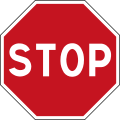
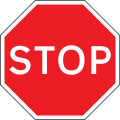


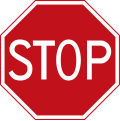

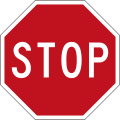

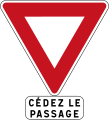
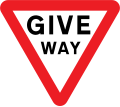
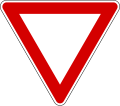
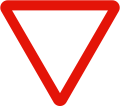
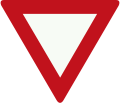
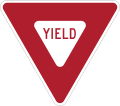
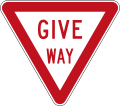




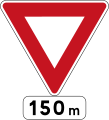

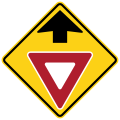




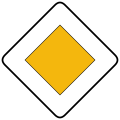
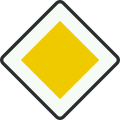
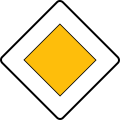

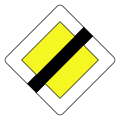

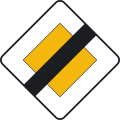

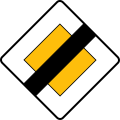


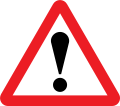
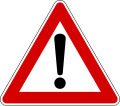


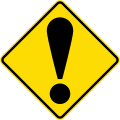

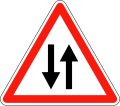
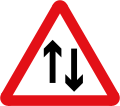
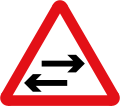

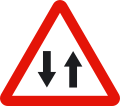
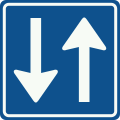
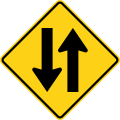
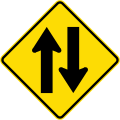

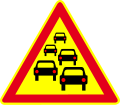
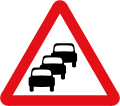

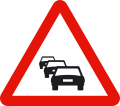


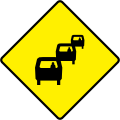

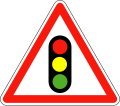
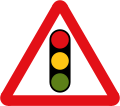
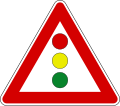
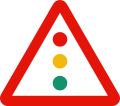

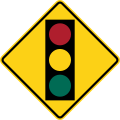

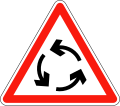
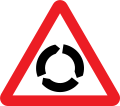
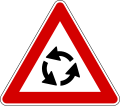
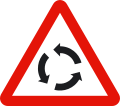

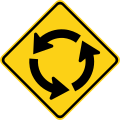


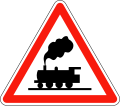
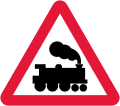
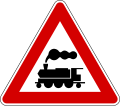

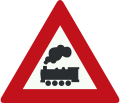
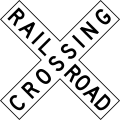
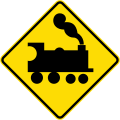
![Bahnübergang mit Schranken [nb 1]](http://up.wiki.x.io/wikipedia/commons/thumb/1/16/Zeichen_150_-_Bahn%C3%BCbergang_mit_Schranken_oder_Halbschranken%2C_StVO_1970.svg/120px-Zeichen_150_-_Bahn%C3%BCbergang_mit_Schranken_oder_Halbschranken%2C_StVO_1970.svg.png)
